Of
all the historically significant political/military events of the 20th
Century, none have had more official explanations than the so called
“Roswell incident”.
always nazis ..lurking in the "background" ..always huh :o u just don't wanna C 
What the Roswell Daily Record really said
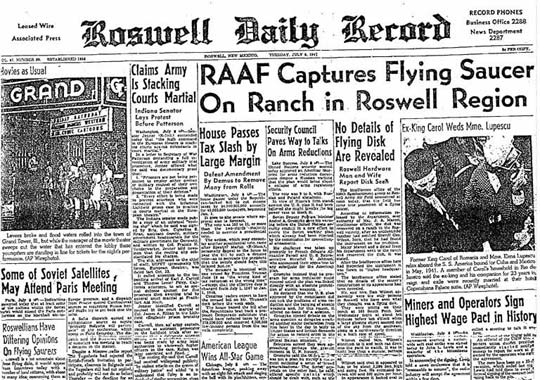 Note: The opinions expressed by the author do not necessarily reflect the opinions of the staff of Open Minds Production.
Note: The opinions expressed by the author do not necessarily reflect the opinions of the staff of Open Minds Production.
Of all the historically significant political/military events of the 20th Century, none have had more official explanations than the so called “Roswell incident”. In fact, as of 2011, the United States government has issued four sanctioned explanations: 1) The crash of a flying saucer, 2) the remains of a weather balloon, 3) the remains of a Project Mogul balloon, 4) Crash test dummies. Logic alone would dictate that if the government lied about the last three explanations, why should the general public believe the first one? A closer examination of the original Roswell Daily Record of July 8, 1947 reveals some interesting details which were there all along.
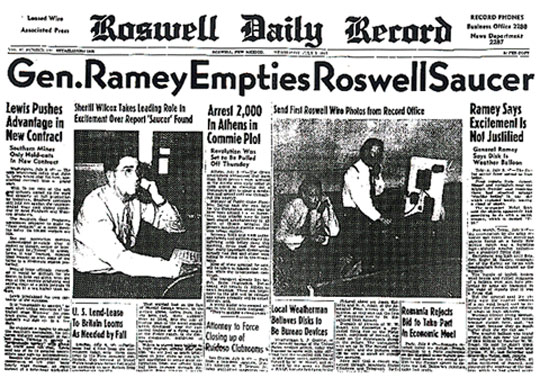 “The intelligence officer of the 509th Bombardment group at the
Roswell Army Air Field announced at noon today, that the field has come
into possession of a flying saucer.” Then, just a few hours later,
General Roger Ramey announced to the world that the object in question
was nothing more than a common ordinary weather balloon (as reported in
the July 9, 1947 issue of the Roswell Daily Record). With this new
explanation, the “Roswell dialectic” had been established. In other
words, the U.S. Army Air Force is essentially “salting the mine”,
forcing the American public to consider one of two possible explanations
(a flying saucer of possible extraterrestrial origin, or a weather
balloon). Curiously, a third option was never presented to the public
which will form the basis for this series. It defies any reasonable
sense of logic to conclude that Major Jesse Marcel (intelligence officer
of the 509th Bomb Group) could fail to identify a common weather
balloon. In addition, according to Karl Pflock in his book Roswell: Inconvenient Facts and the Will to Believe,
(p177) Major Marcel and counter intelligence officer Sheridan Cavitt
found “porous material that you could blow through” scattered around the
Foster ranch. Wouldn’t that defeat the entire purpose of a balloon in
the first place? Note that in the original article, there is absolutely
no mention of any bodies being recovered. Alleged details of
extraterrestrial bodies being involved only crept into the story with
the publication of the book The Roswell Incident by Charles
Berlitz and William Moore in 1980, thirty three years later. Also of
interest in the article is the eyewitness testimony of Mr. and Mrs.
Wilmot, who claimed to have seen an unusual craft flying silently over
Roswell almost a week earlier on Wednesday July second. Whether or not
this sighting had a direct link to the Roswell event is a matter of
debate. However, their descriptions of the craft are worth noting. The
Wilmot’s described the vehicle as “oval in shape”, and approximately
twenty feet in diameter. It was flying at an altitude of 1,500 feet, and
a speed of approximately 400 to 500 mph (far too slow to be an
inter-stellar craft). The original article also states that the
“instrument was flown to higher headquarters”. At this stage of the
Roswell saga, based on only considering the original Roswell Daily
Record article, there is no reason to believe that alien bodies were
involved. In addition, we can also conclude that Col. William Blanchard
(RAAF base commander) would never have authorized the multiple B-29
flights to “higher headquarters” if only a weather balloon was
recovered. However, even these highly secure flights don’t conclusive
proof that the Roswell incident represented something extraterrestrial
in origin.
“The intelligence officer of the 509th Bombardment group at the
Roswell Army Air Field announced at noon today, that the field has come
into possession of a flying saucer.” Then, just a few hours later,
General Roger Ramey announced to the world that the object in question
was nothing more than a common ordinary weather balloon (as reported in
the July 9, 1947 issue of the Roswell Daily Record). With this new
explanation, the “Roswell dialectic” had been established. In other
words, the U.S. Army Air Force is essentially “salting the mine”,
forcing the American public to consider one of two possible explanations
(a flying saucer of possible extraterrestrial origin, or a weather
balloon). Curiously, a third option was never presented to the public
which will form the basis for this series. It defies any reasonable
sense of logic to conclude that Major Jesse Marcel (intelligence officer
of the 509th Bomb Group) could fail to identify a common weather
balloon. In addition, according to Karl Pflock in his book Roswell: Inconvenient Facts and the Will to Believe,
(p177) Major Marcel and counter intelligence officer Sheridan Cavitt
found “porous material that you could blow through” scattered around the
Foster ranch. Wouldn’t that defeat the entire purpose of a balloon in
the first place? Note that in the original article, there is absolutely
no mention of any bodies being recovered. Alleged details of
extraterrestrial bodies being involved only crept into the story with
the publication of the book The Roswell Incident by Charles
Berlitz and William Moore in 1980, thirty three years later. Also of
interest in the article is the eyewitness testimony of Mr. and Mrs.
Wilmot, who claimed to have seen an unusual craft flying silently over
Roswell almost a week earlier on Wednesday July second. Whether or not
this sighting had a direct link to the Roswell event is a matter of
debate. However, their descriptions of the craft are worth noting. The
Wilmot’s described the vehicle as “oval in shape”, and approximately
twenty feet in diameter. It was flying at an altitude of 1,500 feet, and
a speed of approximately 400 to 500 mph (far too slow to be an
inter-stellar craft). The original article also states that the
“instrument was flown to higher headquarters”. At this stage of the
Roswell saga, based on only considering the original Roswell Daily
Record article, there is no reason to believe that alien bodies were
involved. In addition, we can also conclude that Col. William Blanchard
(RAAF base commander) would never have authorized the multiple B-29
flights to “higher headquarters” if only a weather balloon was
recovered. However, even these highly secure flights don’t conclusive
proof that the Roswell incident represented something extraterrestrial
in origin.
Within the test of the Roswell Daily Record article, no detailed descriptions of the debris are present, and as Kal Korff highlighted on page 27 of his publication The Roswell UFO Crash:
“Unfortunately, a careful reading of Moore and Berlitz’s Roswell Incident reveals that despite the impressive claim of having “interviewed more than seventy witnesses”, the testimonies of just twenty-five people are presented. Out of these twenty-five, only seven of them are firsthand sources who claim to have seen the alleged saucer debris, and one of these suspect. Of these seven people however, only five of them claim to have actually handled the material personally, and one of them is adamant that it was not from an extraterrestrial spacecraft”.
Examining the debris
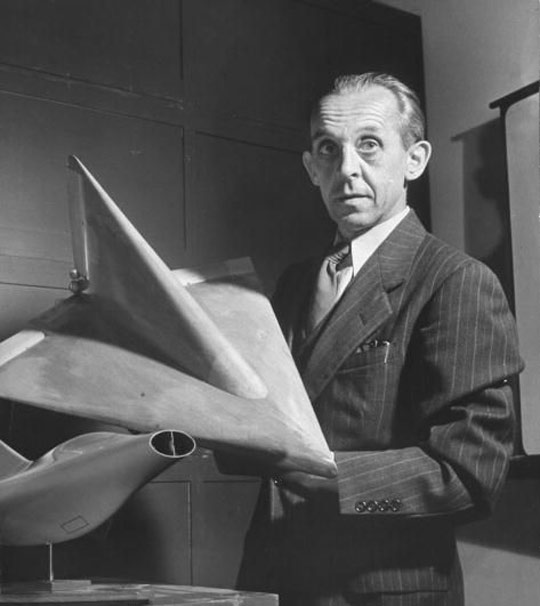 When trying to “crack the case” with respect to the Roswell incident,
every scenario must be thoroughly examined, regardless of any
preconceived ideas, or how uncomfortable the truth may ultimately be.
Immediately after the incident at Roswell during early July of 1947,
debris started arriving at Wright Field (Dayton Ohio). What made this
facility so important to the overall Roswell account? First of all,
Wright Field was the head quarters of General Nathan Twining’s Air
Material Command. It has been well established that Wright Field was
also the destination of many former Nazi aeronautical engineers who came
to America under Operation Paperclip, which was officially created by
President Truman in August of 1945. One particular scientist who was
brought over from Germany was Dr. Alexander Lippisch. His expertise was
in the field of supersonic flight, and flying wing aircraft design.
Could it be that the Roswell debris was flown to Wright Field so that
former Nazi aeronautical engineers could examine it, and to determine if
anything “looked familiar”?
When trying to “crack the case” with respect to the Roswell incident,
every scenario must be thoroughly examined, regardless of any
preconceived ideas, or how uncomfortable the truth may ultimately be.
Immediately after the incident at Roswell during early July of 1947,
debris started arriving at Wright Field (Dayton Ohio). What made this
facility so important to the overall Roswell account? First of all,
Wright Field was the head quarters of General Nathan Twining’s Air
Material Command. It has been well established that Wright Field was
also the destination of many former Nazi aeronautical engineers who came
to America under Operation Paperclip, which was officially created by
President Truman in August of 1945. One particular scientist who was
brought over from Germany was Dr. Alexander Lippisch. His expertise was
in the field of supersonic flight, and flying wing aircraft design.
Could it be that the Roswell debris was flown to Wright Field so that
former Nazi aeronautical engineers could examine it, and to determine if
anything “looked familiar”?
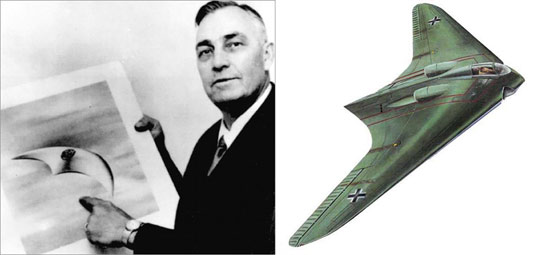 Also of special note, is a curious and often overlooked comment made by Col. Philip Corso on page three of his book The Day after Roswell.
Col. Corso writes: “And this is not to mention the military fears at
first that the craft might have been an experimental Soviet weapon,
because it bore a resemblance to some of the German designed aircraft
that had made their appearances near the end of the war, especially the
crescent-shaped Horton flying wing”. Therefore, according to Philip
Corso, and based on his previous experience, the Roswell craft “looked
German” to him. Brothers Walter and Reimer Horten were pilots for the
German Air Force, and excelled in the design of flying wing gliders.
They later designed and built the famous Horten 229 jet powered flying
wing aircraft which first flew on December 18, 1944. Just prior to the
Roswell event, dozens of newspapers around the country reported
sightings of “flying saucers” which have come to be known as the “flap
of 1947”. They were primarily reported in the vicinity of New Mexico.
Indeed, two weeks previously, pilot Kenneth Arnold’s sighting of nine
“flying saucers’ over Mt. Rainier on June 24, 1947 sparked the modern
UFO era in America. His descriptions of seeing crescent shaped craft
closely resemble the flying wing designs of the Horten Brothers. A
post-war development of the flying wing design (under the direction of
Reimer Horten) utilizing an advanced field propulsion system cannot be
underestimated. It is known that Reimer Horten immigrated to Argentina
after the war which was coincidentally the location of many former
members of the Third Reich. Many of the reports indicated that flying
saucers were seen over sensitive American military installations. This
raises an interesting question, with potentially explosive implications.
If an “alien” race was visiting our planet, and they developed
technology that was perhaps millions of years ahead of our own, why
would they bother monitoring obsolete and antiquated liquid rocket test
facilities, and atomic bomb production centers? On the surface, this
appears to be a terrestrial intelligence which may be “keeping tabs” on
their adversary. This of course raises the uncomfortable possibility
that there was indeed a separate and completely independent “Nazi
International” that survived the war as proposed in Joseph Farrell’s
largely forgotten book Roswell and the Reich.
Also of special note, is a curious and often overlooked comment made by Col. Philip Corso on page three of his book The Day after Roswell.
Col. Corso writes: “And this is not to mention the military fears at
first that the craft might have been an experimental Soviet weapon,
because it bore a resemblance to some of the German designed aircraft
that had made their appearances near the end of the war, especially the
crescent-shaped Horton flying wing”. Therefore, according to Philip
Corso, and based on his previous experience, the Roswell craft “looked
German” to him. Brothers Walter and Reimer Horten were pilots for the
German Air Force, and excelled in the design of flying wing gliders.
They later designed and built the famous Horten 229 jet powered flying
wing aircraft which first flew on December 18, 1944. Just prior to the
Roswell event, dozens of newspapers around the country reported
sightings of “flying saucers” which have come to be known as the “flap
of 1947”. They were primarily reported in the vicinity of New Mexico.
Indeed, two weeks previously, pilot Kenneth Arnold’s sighting of nine
“flying saucers’ over Mt. Rainier on June 24, 1947 sparked the modern
UFO era in America. His descriptions of seeing crescent shaped craft
closely resemble the flying wing designs of the Horten Brothers. A
post-war development of the flying wing design (under the direction of
Reimer Horten) utilizing an advanced field propulsion system cannot be
underestimated. It is known that Reimer Horten immigrated to Argentina
after the war which was coincidentally the location of many former
members of the Third Reich. Many of the reports indicated that flying
saucers were seen over sensitive American military installations. This
raises an interesting question, with potentially explosive implications.
If an “alien” race was visiting our planet, and they developed
technology that was perhaps millions of years ahead of our own, why
would they bother monitoring obsolete and antiquated liquid rocket test
facilities, and atomic bomb production centers? On the surface, this
appears to be a terrestrial intelligence which may be “keeping tabs” on
their adversary. This of course raises the uncomfortable possibility
that there was indeed a separate and completely independent “Nazi
International” that survived the war as proposed in Joseph Farrell’s
largely forgotten book Roswell and the Reich.
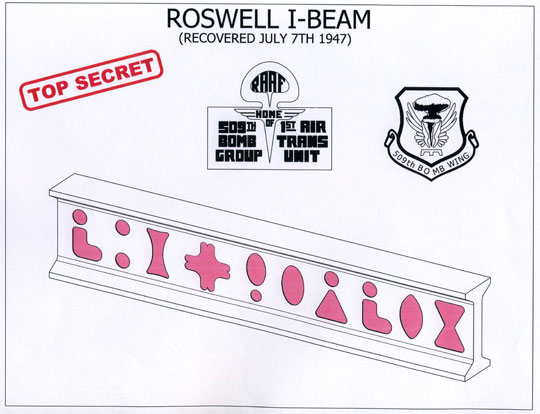 The linchpin to Roswell was always the debris that was recovered.
Indeed, “the devil is in the details”. On the morning of July 8, 1947
both Major Jesse Marcel and CIC commander Sheridan Cavitt first laid
eyes on the debris which was scattered across the Foster ranch.
Researchers Stanton Friedman and William Moore conducted an extensive
interview with Marcel in 1979 for the book The Roswell Incident.
What is interesting to note, is that Marcel never mentioned seeing an
entire craft or bodies. Indeed, as Marcel states on page 69: “I saw
a-lot of wreckage, but no complete machine”. According to Marcel, he
saw/handled the following material:
The linchpin to Roswell was always the debris that was recovered.
Indeed, “the devil is in the details”. On the morning of July 8, 1947
both Major Jesse Marcel and CIC commander Sheridan Cavitt first laid
eyes on the debris which was scattered across the Foster ranch.
Researchers Stanton Friedman and William Moore conducted an extensive
interview with Marcel in 1979 for the book The Roswell Incident.
What is interesting to note, is that Marcel never mentioned seeing an
entire craft or bodies. Indeed, as Marcel states on page 69: “I saw
a-lot of wreckage, but no complete machine”. According to Marcel, he
saw/handled the following material:
1) Beams made of a balsa wood like material.
a) were approximately ½” square
b) had “hieroglyphic” symbols
c) were flexible but not breakable
d) would not burn
2) Parchment like material
a) brown in color
b) extremely strong
c) could not be burned
d) included numbers with pink and purple hieroglyphic symbols
e) the symbols appeared to be painted on
3) Tin foil like metal
a) very thin, resembling the foil used in a pack of cigarettes
b) could not be dented, even with a sixteen pound sledgehammer
c) could not be cut
d) extremely light
e) was flexible, but would not crease (memory metal)
4) A mysterious metallic looking “black box”
a) several inches square
b) very light
c) could not be opened
Now, it’s important to keep in mind that after closely examining the debris seen by Major Jesse Marcel, we can conclude that indeed, the material was exotic, but not necessarily exotic enough to make it extraterrestrial. Note that Marcel stated that he saw numbers on the parchment like material near the hieroglyphic symbols. How could Marcel have possibly identified numbers on the debris, unless they were an adaptation of standard Arabic or Roman numerals? It’s highly unlikely that he could have deciphered the writing from an “alien” culture. This one point strongly suggests the terrestrial origin for the debris.
Another key figure in the Roswell account is William “Mac” Brazel. Although being the first to discover the debris, he died before researchers were able to track him down for comment. Fortunately, his son Bill was still alive, and was interviewed by co-author William Moore in 1979. Bill mentioned that even after the military had cleaned up the debris field, he was still able to find small pieces of wreckage after heavy rain-fall. After approximately two years, he was able to accumulate enough to fill a small cigar box. Bill described picking up some very light wooden-like particles. The material was pliable, but could not be broken or scratched. He also described seeing a dark tin foil like material which could not be torn. It was very lightweight, and could not be creased. As Bill states: “the odd thing about this foil, was that you could wrinkle it, and lay it back down, and it immediately resumed its original shape”. This is of course a reference to the famed “memory metal” described by multiple Roswell eyewitnesses. He also described some thread-like material that resembled silk. Bill also recalled that there was no writing on the material he recovered. Unfortunately, Bill’s small collection of debris was ultimately confiscated by the United States Army making an independent analysis of the wreckage impossible. Bill’s description of the debris closely matches that of Marcel, and he also stated that his father “Mac” never saw any bodies or creatures associate with the wreckage. As stated earlier, the debris may indeed have been exotic, but not necessary exotic enough to make it extraterrestrial in origin. Floyd Proctor (Mac Brazel’s neighbor) recalls that one day Mac came over to his house talking about debris that he had found on the ranch that had “designs on it that reminded him of Chinese and Japanese designs…..like the kind of stuff you would find on firecracker wrappers”. These descriptions of writing on the Roswell wreckage don’t automatically infer an extraterrestrial origin, and any claims that these were the work of “aliens” is pure speculation at best.
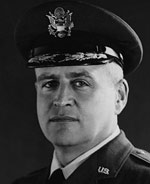 Another interesting point regarding the Roswell wreckage was
highlighted Col. William Blanchard’s widow. In an interview conducted
with Stanton Friedman, and referenced on page 45 of The Roswell Incident,
Blanchard’s widow stated that her husband knew that the wreckage which
was flown to Fort Worth Texas did belong to any type of balloon. She
also stated that “at first he thought it might be Russian because of the
strange symbols on it. Later on, he realized that it wasn’t Russian
either.” As can be determined by the interesting comments made by
Blanchard’s widow, he did not state that the wreckage was
extraterrestrial. Further, he was inclined to originally suspect that it
might be Russian in origin, but later concluded that not to be the
case. However, not being Russian doesn’t necessarily equate to
extraterrestrial.
Another interesting point regarding the Roswell wreckage was
highlighted Col. William Blanchard’s widow. In an interview conducted
with Stanton Friedman, and referenced on page 45 of The Roswell Incident,
Blanchard’s widow stated that her husband knew that the wreckage which
was flown to Fort Worth Texas did belong to any type of balloon. She
also stated that “at first he thought it might be Russian because of the
strange symbols on it. Later on, he realized that it wasn’t Russian
either.” As can be determined by the interesting comments made by
Blanchard’s widow, he did not state that the wreckage was
extraterrestrial. Further, he was inclined to originally suspect that it
might be Russian in origin, but later concluded that not to be the
case. However, not being Russian doesn’t necessarily equate to
extraterrestrial.
Claims of “alien” bodies re-examined
 “One by one I learned that they hadn’t seen alien bodies, and their
stories, while quite exciting, were not based in reality. That seemed to
set the investigation back to its original point, meaning we had only
the testimony of those who had seen the strange metallic debris, who had
walked the debris field on the Foster Ranch, or had seen something in
the air that might have been the craft just prior to the crash.” – Roswell Revisited
Kevin Randle p19. In addition to the debris that was recovered during
the Roswell incident, claims of “alien” bodies associated with the
crash/retrieval have been promoted as proof of its extraterrestrial
origin. Unfortunately, under close examination, the so called “star
witnesses” who claim to have either seen bodies first hand, or knew
someone who did turned out to be second-hand dead man’s testimony, or
totally unreliable. In this installment of Roswell Revelation, we will
explore in detail the eyewitnesses who claim to have actually seen
“alien” bodies.
“One by one I learned that they hadn’t seen alien bodies, and their
stories, while quite exciting, were not based in reality. That seemed to
set the investigation back to its original point, meaning we had only
the testimony of those who had seen the strange metallic debris, who had
walked the debris field on the Foster Ranch, or had seen something in
the air that might have been the craft just prior to the crash.” – Roswell Revisited
Kevin Randle p19. In addition to the debris that was recovered during
the Roswell incident, claims of “alien” bodies associated with the
crash/retrieval have been promoted as proof of its extraterrestrial
origin. Unfortunately, under close examination, the so called “star
witnesses” who claim to have either seen bodies first hand, or knew
someone who did turned out to be second-hand dead man’s testimony, or
totally unreliable. In this installment of Roswell Revelation, we will
explore in detail the eyewitnesses who claim to have actually seen
“alien” bodies.
Glenn Dennis: The Roswell mortician who claimed knowledge of the bodies from his “nurse friend” known as “Mary Naomi Self” who was present during an alleged autopsy at the base hospital. According to Dennis, she was believed to have later crashed in an airplane accident. Dennis claimed that the nurse in question made a rough drawing of the “aliens” that she allegedly saw at the base hospital. Curiously though, this original sketch was somehow “lost”. After an exhaustive search of military records pertaining to a nurse at Roswell by the name of “Mary Naomi Self”, no records could be found. After cross examination, Dennis later admitted that he lied to Roswell researchers about her actual identity. The fact that Dennis lied to researchers automatically impeaches his testimony. In addition, the fact that the nurse (if she actually ever existed) died in an aircraft accident makes the descriptions of the alleged alien bodies by her second-hand dead person’s testimony.
Frank Kaufmann: Claimed that he not only was part of the Roswell crash/retrieval operation, but that he actually saw two bodies as well. After his death, Roswell researchers were given access to his personal files by his widow Juanita Kaufmann. When looking through the material, researchers found “cut and paste” forged documents relating to his military background which thereby impeaches his testimony. Specifically, Kaufmann’s SQR (Separation Qualification Record) showed signs of discoloration from the rubber cement used to fake the document. In addition, an Underwood typewriter of World War II vintage was discovered. When characters from that typewriter were compared to proven counterfeit documents, they were an exact match. Researchers also discovered that he was never listed in the Roswell Army Air Field yearbook of 1947.
Jim Ragsdale: Totally discredited by Roswell researchers. Changed his story multiple times, and even claimed to have recovered “golden helmets” from the dead crew of the craft.
Barney Barnett: Second-hand dead man’s testimony. Barnett claimed to have seen a crashed saucer with alien bodies in the “Plains of San Augustin” sometime during the late 1940’s. He provided no corroborating witnesses to his story. Claimed that the crash site was actually 150 west of the Foster ranch, making it much too far away to have any military involvement from Roswell Army Air Field. Roswell researchers uncovered Ruth Barnett’s diary which showed that her husband was home in Socorro NM during early July of 1947, and could not have been in the vicinity of the crash site as first proposed in The Roswell Incident.
Gerald Anderson: No longer credible according to Roswell researchers. First came to light after the TV series Unsolved Mysteries did a segment on Roswell which aired in January of 1990. Claimed to have seen wreckage and four “creatures” (three dead, and one still alive), but was only six years old at the time of the alleged incident. Changed his story multiple times, and admitted to falsifying documents. Statements from Anderson’s cousin indicate that an alleged original “journal” of the crash, and “wreckage” were apparently buried “out there”. However, this alleged smoking gun evidence has never been found.
William “Mac” Brazel: Although Mac Brazel was certainly a respectable rancher, Roswell researches never questioned him before he died in 1963. Therefore, statements regarding Mac’s descriptions of “unfortunate little creatures” which originated from Roswell radio station board man Frank Joyce represent second-hand dead man’s testimony. In addition, Brazel never gave any detailed descriptions of the bodies other than to say that they “weren’t green”.
From the shaky and unsubstantiated testimony of the above “eyewitnesses”, a very weak case can be made that the so called Roswell bodies were extraterrestrial in origin. In fact, the alleged “nurse” mentioned by Glenn Dennis described the bodies as having the following traits:
1) looked like ancient Chinese
2) were small and fragile
3) had no hair
4) their noses did not protrude
5) the eyes were set deep in the heads
6) the ears were little indentations
7) their upper arms were longer than their lower arms
8) they had no thumbs, and only for fingers
9) had large heads out of proportion to the rest of the body
10) small stature, that of “ten year old children” between four to five feet in height
While it can be argued that the above traits are unusual, to say that they represented anything extraterrestrial is a huge leap in interpretation, and cannot be conclusively proven by any of the so called “star witnesses” involved in the Roswell incident.
The Corso Connection
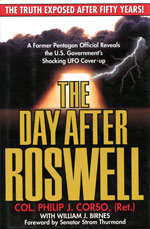 Major Jesse Marcel never thought that what he retrieved on the Foster
ranch during the early morning hours of July 7, 1947 were the remains
of an extraterrestrial vehicle. In fact, according to the publication Roswell, Inconvenient Facts and the Will to Believe (written
by the late Karl Pflock) Major Marcel did an interview in April of 1978
with the late Leonard Stringfield (of UFO crash/retrieval fame) and
Chicago radio personality Steve Tom. During the interview, “Marcel had
indicated he never even considered the “alien” part of things as a
possible explanation until UFO researchers started suggesting the idea
to him”.
Major Jesse Marcel never thought that what he retrieved on the Foster
ranch during the early morning hours of July 7, 1947 were the remains
of an extraterrestrial vehicle. In fact, according to the publication Roswell, Inconvenient Facts and the Will to Believe (written
by the late Karl Pflock) Major Marcel did an interview in April of 1978
with the late Leonard Stringfield (of UFO crash/retrieval fame) and
Chicago radio personality Steve Tom. During the interview, “Marcel had
indicated he never even considered the “alien” part of things as a
possible explanation until UFO researchers started suggesting the idea
to him”.
In addition, the testimony of 1st Lt. Chester Barton should not go unnoticed. Interviewed by researcher Joseph Stefula, Lt. Barton was a crypto specialist with the 509th communications unit. He was ordered to the crash site personally by RAAF Provost Marshal Major Edwin Easley. Upon arrival, Baron recalled seeing the extreme level of security associated with the crash. He also remembered seeing an impact site with at least three large burned areas. Although he never got closer than fifty yards from the wreckage, Barton was certain that what he saw had absolutely nothing to do with a weather balloon. Since there were MP’s with Geiger-counters stationed around the crash site, he originally thought it was the remains of a B-29 that had crashed carrying an atomic bomb. Low levels of radiation were detected at the impact site (this would immediately rule out a weather balloon). Note that Lt. Barton never mentioned anything about an extraterrestrial spacecraft, only that the remains resembled that of a crashed aircraft. However, an exhaustive search of Army Air Force records indicated that there were no aircraft crashes in that vicinity during the time of the incident. He also mentioned that there were no signs of any propellers or engines. This leads to the strong possibility that what crashed was certainly terrestrial in origin, but not necessarily American made.
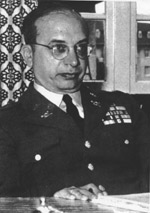 Enter the late Col. Philip J. Corso who burst onto the scene in 1997 with his shocking book The Day after Roswell.
Corso stated that he inherited the Foreign Technology Desk (Research
and Development) at the Pentagon in 1961. According to Corso, on page
four, General Arthur Trudeau asked him:
Enter the late Col. Philip J. Corso who burst onto the scene in 1997 with his shocking book The Day after Roswell.
Corso stated that he inherited the Foreign Technology Desk (Research
and Development) at the Pentagon in 1961. According to Corso, on page
four, General Arthur Trudeau asked him:
“to use the Army’s ongoing weapons development and research program as a way to filter the Roswell technology into the mainstream of industrial development through the military defense contracting program. Today, items such as lasers, integrated circuitry, fiber optics networks, accelerated particle-beam devices, and even the Kevlar material used in bulletproof vests are all commonplace. Yet the seeds for the development of all of them were found in the crash of the alien craft at Roswell and turned up in my files fourteen years later”.
Corso also maintains that all the from the Roswell incident were stored in his office in a single locked filing cabinet which also included some of the actual debris. However, when reviewing the underlying premise of Corso’s book, two red flags immediately present themselves: 1) as nuclear physicist and Roswell researcher Stanton Friedman points out, why would the U.S. Army entrust the analysis and reverse-engineering of a recovered extraterrestrial craft and its technologies to a (then) mere lieutenant colonel with absolutely no engineering or scientific background? 2) By his own admission, even Corso’s own son Philip J Corso Jr. pointed out that the book was ninety percent pure fabrication as highlighted in Kevin Randle’s publication Roswell Revisited pp. 118-119.
Corso maintains on page 115 of his book that the following technologies owe their existence to the Roswell incident:
1) Image intensifiers, which ultimately became “night vision”
2) Fiber optics
3) Supertenacity fibers
4) Lasers
5) Molecular aligned metallic alloys
6) Integrated circuits and microminiaturization of logic boards
7) HARP (High Altitude Research Project)
8) Project Horizon (moon base)
9) Portable atomic generators (ion propulsion drive)
10) Irradiated Food
11) “Third Brain” guidance systems (EBE headbands)
12) Particle beams (“Star Wars” antimissile energy weapons)
13) Electromagnetic propulsion systems
14) Depleted uranium projectiles
However, do these technologies represent something that originated “off world”, or could they have been designed and developed by a very terrestrial (yet high tech) organization? However, on page four of his book, Corso suspects that the Roswell technology resembled that of the Nazi’s during the war:
“In those confusing hours after the discovery of the crashed Roswell alien craft, the Army determined that in the absence of any other information, it had to be extraterrestrial. Worse, the fact that this craft and other flying saucers had been surveying our defensive installations and even seemed to evidence a technology we’d seen evidenced by the Nazi’s caused the military to assume these flying saucers had hostile intentions and might have interfered in human events during the war.”
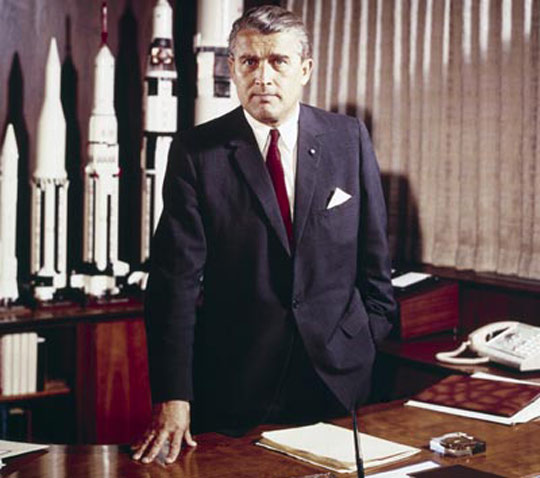
 Apparently, as Dr. Joseph Farrell points out in his book Roswell and the Reich
(pg. 245) the resemblance of the Roswell craft to that of previously
identified Nazi technology was so strong, that when Corso established
the secret team to “reverse engineer” and then “seed” all of the
recovered “extraterrestrial” technology into American industry, he went
to his superior officer General Trudeau, to see if he could bring in
certain former Nazi scientists and engineers for a “second look” for
“advice”. These included Dr. Werner von Braun, and Dr. Hermann Oberth
(both rocket scientists who worked on the V-2 during the war). In
addition, he also called on the expertise of Hans Kohler (inventor of
the Kohler coil). This invention consists of a series of magnets which
are arranged in a hexagonal pattern, around which were wound coils in an
unusual circuit. The coil contained no power source, and could produce
electrical current seemingly from nowhere, just by the odd configuration
of the magnets and coils.
Apparently, as Dr. Joseph Farrell points out in his book Roswell and the Reich
(pg. 245) the resemblance of the Roswell craft to that of previously
identified Nazi technology was so strong, that when Corso established
the secret team to “reverse engineer” and then “seed” all of the
recovered “extraterrestrial” technology into American industry, he went
to his superior officer General Trudeau, to see if he could bring in
certain former Nazi scientists and engineers for a “second look” for
“advice”. These included Dr. Werner von Braun, and Dr. Hermann Oberth
(both rocket scientists who worked on the V-2 during the war). In
addition, he also called on the expertise of Hans Kohler (inventor of
the Kohler coil). This invention consists of a series of magnets which
are arranged in a hexagonal pattern, around which were wound coils in an
unusual circuit. The coil contained no power source, and could produce
electrical current seemingly from nowhere, just by the odd configuration
of the magnets and coils.
Therefore, as the actions of Col. Corso point out, in multiple instances, he is pointing the finger to Nazi Germany, and to technologies rarely explored by the UFO community in general.
The Doctor and the debris
 Of all the unlikely sources for a Roswell connection, a book
highlighting the astounding accounts of “clinically dead” patients might
be the most unusual of all. Dr. John Lerma, author of Learning from the Light,
recounts the spiritual experiences of the terminally ill. Certainly
this is a far cry from the mechanical world of wreckage and secretive
intelligence briefings. The book relays the story of one particular
patient who may have had a direct connection to the Roswell incident.
Known only as “Colonel Marshall Bradfield”, his story didn’t contain
anything relating to “alien” bodies, but something potentially more
politically explosive. According to Dr. Lerma, his patient was born into
a military family in Roswell in 1923. He joined the Army in December of
1941, and graduated from West Point as a physicist six years later.
After graduation, he went to work with the Army Science and Technology
division on highly classified projects.
Of all the unlikely sources for a Roswell connection, a book
highlighting the astounding accounts of “clinically dead” patients might
be the most unusual of all. Dr. John Lerma, author of Learning from the Light,
recounts the spiritual experiences of the terminally ill. Certainly
this is a far cry from the mechanical world of wreckage and secretive
intelligence briefings. The book relays the story of one particular
patient who may have had a direct connection to the Roswell incident.
Known only as “Colonel Marshall Bradfield”, his story didn’t contain
anything relating to “alien” bodies, but something potentially more
politically explosive. According to Dr. Lerma, his patient was born into
a military family in Roswell in 1923. He joined the Army in December of
1941, and graduated from West Point as a physicist six years later.
After graduation, he went to work with the Army Science and Technology
division on highly classified projects.
During the summer of 1947, Bradfield returned to Roswell to spend the July fourth weekend with his mother and father. As has always been reported by Roswell investigators from the beginning, heavy thunderstorms and lighting rolled into the area by July third. The following morning, it was a clear day, and it appeared as though it was going to be another hot day in Roswell. However, around 6:45 in the morning, none other than rancher Mac Brazel showed up at his doorstep. Brazel seemed excited yet somewhat distressed at what had occurred the night before. Then, Brazel urged Bradfield to come over to his ranch immediately. Both of them left in Brazel’s pickup truck, and headed out to the Foster ranch. Dr. Joseph Farrell picks up the story on page 449 of Roswell and the Reich:
Brazel began sharing what had occurred the night before, and what he had found on his ranch. He thought he had heard a crash the night before, but had attributed it to the thunderstorm that had passed. It was not until the next morning, as he drove over his land, that he discovered hundreds of pieces of metal strewn over several hundred yards around the property. He described the metal pieces as being anywhere from a couple of inches to several feet in size, the largest of which sported an emblem that was very familiar to him. What was not familiar to him was the quality of the metal, which apparently had memory. In other words, he said that it was thin, like foil, and he could crunch it up only to see it expand back to its original shape in a few minutes. He told me he had seen geometrically shaped symbols on some of the metal fragments.
When they finally arrived at the ranch, Bradfield jumped out of the truck and assumed he was looking at the crash site of a conventional aircraft. However, there was no hint of the smell of aircraft fuel, or any evidence of fire. He also observed U.S. Army vehicles traveling northwest of the ranch. Farrell continues on page 450:
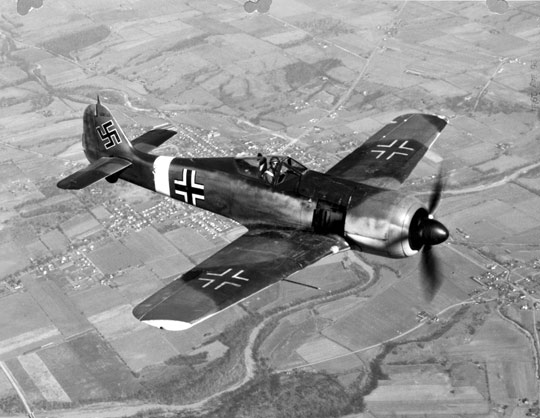
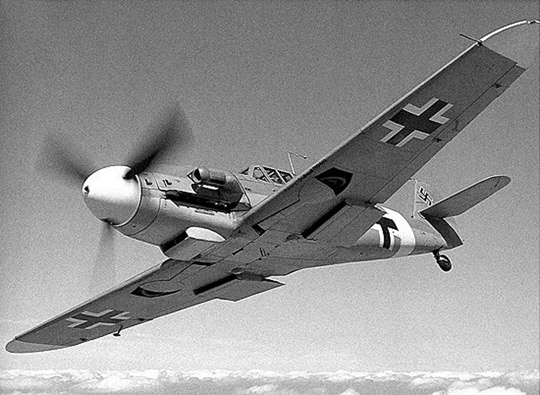 Bradfield knew at that moment that something highly secure had
crashed in the area, and that an Army retrieval team had been called in.
He also made note of several facts: the lack of airplane fuel on the property, the small size of the debris, the
lack of engine parts, the lack of evidence of fire, and an incomplete
emblem. With a cold chill running up his spine, he found the shape to be
vague, but frighteningly familiar. As he pieced parts of the emblem
together, it increasingly resembled the German Iron Cross,
(believed by Farrell to have actually been a German “Balkenkruez” cross)
which Hitler used on his military vehicles and aircraft. Bradfield felt
twinges of fear deep in his gut, and knew that this incident had a much
higher level of security than his clearance made him privy to, and as
such, he knew the consequences of being found in the area around the
crash site.
Bradfield knew at that moment that something highly secure had
crashed in the area, and that an Army retrieval team had been called in.
He also made note of several facts: the lack of airplane fuel on the property, the small size of the debris, the
lack of engine parts, the lack of evidence of fire, and an incomplete
emblem. With a cold chill running up his spine, he found the shape to be
vague, but frighteningly familiar. As he pieced parts of the emblem
together, it increasingly resembled the German Iron Cross,
(believed by Farrell to have actually been a German “Balkenkruez” cross)
which Hitler used on his military vehicles and aircraft. Bradfield felt
twinges of fear deep in his gut, and knew that this incident had a much
higher level of security than his clearance made him privy to, and as
such, he knew the consequences of being found in the area around the
crash site.
After viewing the debris, Bradfield asked Brazel to drive him home immediately, after which he called his commander at Wright Field (Dayton Ohio). However, there a few discrepancies with the Colonels story, and they deserve to be addressed:
1) The account of “Colonel Marshall Bradfield” as told in Dr. John Lerma’s book Learning from the Light represents second-hand dead man’s testimony. However, if the testimony of witnesses such as Oliver “Pappy” Henderson and Melvin Brown can be considered reliable with respect to the Roswell case, why not that of Colonel Bradfield?
2) The second issue has to do with timing. As highlighted in a previous installment in this series, there was no military presence or “boots on the ground” regarding the Roswell incident until the morning of July seventh when Mac Brazel led Major Jesse Marcel and C.I.C. commander Shearidan Cavitt out to the debris field on the Foster ranch. Therefore, the Colonel’s statement that he saw “U.S. Army vehicles travelling northwest” the morning after the incident occurred (which would have been July fourth) appears to be incorrect.
The impact of Colonel Bradfield’s discovery could have potentially bombshell political implications. If eventually proven to be true, it would mean that in point of fact there was a separate post-war “Nazi International” in operation, and that America did not “get everything”. At this stage in the Roswell investigation, Col. Bradfield’s testimony cannot be independently confirmed by a secondary source. However it could potentially add another significant piece to the overall Roswell jigsaw puzzle.
The Bombshell Document

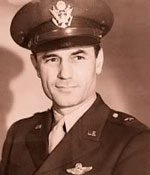 In October of 1947, Brigadier General George F. Schulgen composed a
memorandum which outlined the intelligence collection needs of the
United States Air Force. This six page document has come to be known as
the Schulgen Collection Memorandum. It appears that this
document was written in response to both the “flap of 1947”, and the
Roswell incident directly. It’s important to note right from the
beginning that through the efforts of the late Roswell researcher Robert
G. Todd, both a fake and authentic version of this document has been
identified. Unfortunately, some Roswell researchers have twisted the
wording of this memorandum to fit their preconceived ideas. We will
consider only the authentic version which will be reproduced for clarity
in its entirety, and then provide a detailed analysis of each page.
In October of 1947, Brigadier General George F. Schulgen composed a
memorandum which outlined the intelligence collection needs of the
United States Air Force. This six page document has come to be known as
the Schulgen Collection Memorandum. It appears that this
document was written in response to both the “flap of 1947”, and the
Roswell incident directly. It’s important to note right from the
beginning that through the efforts of the late Roswell researcher Robert
G. Todd, both a fake and authentic version of this document has been
identified. Unfortunately, some Roswell researchers have twisted the
wording of this memorandum to fit their preconceived ideas. We will
consider only the authentic version which will be reproduced for clarity
in its entirety, and then provide a detailed analysis of each page.
SECRET
Inclosure No. 1
1. Research and development
a. What German scientists had a better than average knowledge of the Horten Brothers work and perspective thinking; where are these scientists now located, and what is their present activity? Should be contacted and interrogated.
b. What Russian factories are building the Horten VIII design?
c. Why are the Russians building 1,800 of the Horten VIII design?
d. What is their contemplated tactical purpose?
e. What is the present day activity of the Horten brothers, Walter and Riemar?
f. What is known of the whereabouts of the entire Horten family, particularly the sister? All should be contacted and interrogated regarding any contemplated plans or perspective thinking of the Horten brothers, and any interest shown by the Russians to develop their aircraft.
g. Are any efforts being made to develop the Horten “Parabola” or modify this configuration to approximate an oval or disc?
h. What is the Horten perspective thinking on internal controls or controls that are effective mainly by streams of air or gas originating from within the aircraft to supplant conventional external surface controls?
2. Control
For any aircraft whose shape approximates that of an oval, disc, or saucer, information regarding the following items is requested:
a. Boundary layer control method by suction, blowing, or a combination of both
b. Special controls for effective maneuverability at very low speeds or extremely high altitudes.
c. Openings either in the leading edge top and bottom surfaces that are employed chiefly to accomplish boundary layer control or for the purpose of reducing the induced drag. Any openings in the leading edge should be reported and described as to shape, size etc. This investigation is significant to justify a disc shape configuration for long range application.
SECRET
d. Approximate airfoil shape in the center and near the tips.
e. Front view and rear view shape.
3. Items of Construction
a. Type of material, whether metal, ferrous, non-ferrous, or non-metallic.
b. Composite or sandwich construction utilizing various combinations of metals, plastics, and perhaps balsa wood.
c. Unusual fabrication methods to achieve extreme light weight and structural stability particularly in connection with great capacity for fuel storage.
4. Items of Arrangement
a. Special provisions such as retractable domes to provide unusual observation for the pilot or crew members.
b. Crew number and accommodation facilities.
c. Pressurized cabin equipment.
d. High altitude or high speed escapement methods.
e. Methods of pressurization or supercharging from auxiliary units or from the prime power plant.
f. Provisions for towing – especially with short fixed bar, and for re-fueling in flight.
g. Provisions for assisted take off application.
h. Bomb bay provisions, such as dimensions, approximate location, and unusual features regarding the opening and closing of the doors.
5. Landing Gear
a. Indicate type of landing gear – whether conventional, tricycle, multiple wheel, etc.
b. Retractable, and jettison features for hand gear.
c. Provisions for takeoff from ice, snow, or water.
d. Skid arrangements for either takeoff or landing.
SECRET
6. Power Plant
a. Information is needed regarding the propulsion system used in the aircraft. Possible types of engines that could be employed include:
(1) Reciprocating (piston type) engine or gas turbine. Either or both of these could be used to drive propellers of conventional or special design, rotating vanes, ducted fans, or compressors.
(2) Jet propulsion engines including turbo jets, rockets, ramjets, pulse jets, or a combination of all four.
(3) Nuclear propulsion (atomic energy). Atomic energy engines would probably be unlike any familiar type of engine, although atomic engines might be employed in combination with any of the above types.
Aircraft would be characterized by lack of fuel systems and fuel storage place.
b. The power plant would likely be an integral part of the aircraft and could possibly not be distinguished as an item separate from the aircraft. If jet propulsion is used, large air handling capacity, characterized by a large air inlet and large exhaust nozzle, should be evident. The size of entrance and exit areas would be of interest. It is possible that the propulsive jet is governed or influenced for control of the aircraft. The presence of vanes or control surfaces in the exhaust or methods of changing the direction of the object should be observed.
c. Information desired on the propulsion systems pertains to the following items:
(1) Type of power plant or power plants.
(2) General description.
(3) Rating (thrust, horsepower, or air flow).
(4) Type of fuel
(5) Catalytic agents for super-performance or normal cruising power.
SECRET
DRAFT OF COLLECTION MEMORANDUM
OBJECT
1. This Memo sets forth the current intelligence requirements in the field of Flying Saucer type aircraft.
GENERAL
1. An alleged “Flying Saucer” type aircraft or object in flight, approximating the shape of a disc, has been reported by many observers from widely scattered places, such as the United States, Alaska, Canada, Hungary, the Island of Guam, and Japan. This object has been reported by many competent observers, including USAF rated officers. Sightings have been made from the ground as well as from the air.
2. Commonly reported features that are very significant and which may aid in the investigation are as follows:
a. Relatively flat bottom with extreme light-reflecting ability.
b. Absence of sound except for an occasional roar when operating under super performance conditions.
c. Extreme maneuverability and apparent ability to almost hover.
d. A plan form approximating that of an oval or disc with a dome shape on the top surface.
e. The absence of an exhaust trail except in a few instances when it was reported to have a bluish color, like a Diesel exhaust, which persisted for approximately one hour. Other reports indicated a brownish smoke trail that could be the results of a special catalyst or chemical agent for extra power.
f. The ability to quickly disappear by high speed or by complete disintegration.
g. The ability to suddenly appear without warning as if from an extremely high altitude.
h. The size most reported approximated that of a C-54 or Constellation type aircraft.
i. The ability to group together very quickly in a tight formation when more than one aircraft are together.
j. Evasive action ability indicates possibility of being manually operated, or possibly by electronic or remote control devices.
k. Under certain power conditions, the craft seems to have the ability to cut a clear path through clouds — width of path estimated to be approximately one-half mile. Only one incident indicated this phenomenon.
SECRET
3. The first sightings in the U.S. were reported around the middle of May. The last reported sighting took place in Toronto, Canada, 14 September. The greatest activity in the U.S. was during the last week of June and the first week of July.
4. This strange object, or phenomenon, may be considered, in view of certain observations, as long-range aircraft capable of a high rate of climb, high cruising speed (possibly sub-sonic at all times) and highly maneuverable and capable of being flown in very tight formation. For the purpose of analysis and evaluation of the so-called “flying saucer” phenomenon, the object sighted is being assumed to be a manned aircraft, of Russian origin, and based on the perspective thinking and actual accomplishments of the German.
5. There is also a possibility that the Horten brothers’ perspective thinking may have inspired this type of aircraft – particularly the “Parabola”, which has a crescent plan form. Records show that only a glider version was built of this type aircraft. It is reported to have been built in Hellegenberg, Germany, but was destroyed by fire before having ever been flown. The Horten brothers’ latest trend of perspective thinking was definitely toward aircraft configurations of low aspect ratio. The younger brother, Riemar, stated that the “Parabola” configuration would have the least induced drag – which is a very significant statement. The theory supporting this statement should be obtained if possible.
6. The German High Command indicated a definite interest in the Horten type of flying wing and were about to embark on a rigorous campaign to develop such aircraft toward the end of the war. A Horten design, known as the IX, which was designated as the Go-8-229 and the Go-P-60 (night fighter) was to be manufactured by the Gotha Plant. It is reported that a contract for fifty such aircraft was planned, but only three or four were built. This plant is now in the hands of the Russians. A recent report indicates that the Russians are now planning to build a fleet of 1,800 Horten VIII (six engine pusher) type flying wing aircraft. The wing span is 131 feet. The sweepback angle is 30 degrees. The Russian version is reported to be jet propelled.
REQUIREMENTS
1. Requirements appear at Inclosure No. 1.
SPECIAL INSTRUCTIONS
Control No. A-1917
DISTRIBUTION
1. To M.A.’s England, France, Sweden, Finland, USSR, Turkey, Greece, Iran, China, Norway, Philippines, and to Commander-in-Chief, Far East, and Commanding General, United States Air Forces in Europe, through Commanding General, EUCOM.
SECRET
Note on page one of the memorandum (section 1a) the reference to any German scientists familiar with the work of the Horten brothers. In Section 1e, details on the current activity of the Horten brothers are requested. Section 2g asks if any efforts were made to develop the “parabola” configuration. Why is the United States government so interested in their work? As previously stated, Riemar Horten was in Argentina immediately after the war. Page one (Section 2a and 2c) makes mention of boundary layer control by way of openings on the leading edge top and bottom surfaces. This is absolutely a clear indication of man-made technology.
Page 2 (section 3a and 3b): “type of material, whether metal, ferrous, or non-ferrous, or non-metallic and composite or sandwich construction utilizing various combinations of metals, plastics, and perhaps balsa wood.” This section appears to be specifically in direct response the Roswell incident. Note the similarity of the description of the Roswell debris to that of the material listed in this section of the Schulgen memorandum. The specific reference to “non-metallic metals and composite or sandwich construction” clearly indicate that something much more than a weather balloon was recovered.
Page 2 (section 5c): “Provisions for take-off from ice, snow or water.” This section appears to indicate that General Schulgen is asking the question: “Where are these flying saucers coming from?” Could they originate from the plains of Argentina, or perhaps the Arctic regions hinted at by Admiral Richard Byrd? The fact that General Schulgen is specifically requesting detailed information on what type of landing gear the craft uses further indicates a man-made origin.
Page 3 (section 6a 2&3): “Jet propulsion engines including turbo jets, rockets, ramjets, pulse jets, or a combination of all four.”; “Nuclear propulsion (atomic energy).” Here, General Schulgen is certainly listing man-made propulsion systems, and specifically highlights atomic power. A flying saucer that crashed which utilized a nuclear propulsion system would have been completely unknown to members of the 509th Bomb Group in Roswell. Miniaturization of atomic propulsion systems which could propel an aircraft were decades away in America. Also reference the fact that traces of radiation were found at the “impact site” north of Roswell as highlighted in part seven of this series.
Note on page four (section 2b) of the memorandum the reference that the “flying saucers” made a “roar when operating under extreme performance conditions”. Are we really to believe that “aliens” would fly around in our atmosphere in craft which emit a roaring sound? This is a clear indication of the presence of man-made jets, rockets, or ramjets. The reference to “super performance conditions” may be an indication that afterburners were used on the discs.
Page four Section 2c mentions “extreme maneuverability and apparent ability to almost hover”. This characteristic suggests that if a jet is the primary means of propulsion, it has the ability to vector the thrust in VTOL (Vertical Take Off and Landing) applications aka “Harrier style”. This of course would do away with the need for runways which would have made the job of American photo interpreters significantly more difficult.
In addition, the memorandum also makes reference (Page four section 2e) to the craft emitting a “blue colored exhaust trail, like a diesel exhaust”. It also mentions a brown colored smoke trail.” Would extraterrestrials that could potentially by millions of years ahead of our society really be flying around in craft that emit thick brown colored smoke trails? The contrails left by these craft clearly represent an earth based man-made technology, and not anything extraterrestrial. It’s worth noting again that Major Jesse Marcel’s testimony indicates that he never even considered that what he recovered on the Foster ranch had an extraterrestrial origin. In addition, recall the testimony of Colonel Blanchard’s wife who stated that her husband’s original inclination was that the craft was Russian and not extraterrestrial.
Page four (section 2f) states that the flying saucers had the ability to suddenly appear without warning as if from an extremely high altitude. This appears to be a reference to something more than conventional jet engine technology. The ability to “disintegrate” may be referring to an advanced “field propulsion” system which Kurt Debus was working on before World War II. In addition, Ronald Richter was working on an identical program immediately after World War II.
Page five (section 4) states: “For the purpose of analysis and evaluation, of the “flying saucer” phenomenon, the object sighted is being assumed to be a manned aircraft of Russian origin, and based on the perspective thinking and actual accomplishments of the Germans”. Therefore, according to the United States Air Force, the flying saucers which were seen between May through September of 1947 (section 3) were a direct result of the accomplishments of the Germans.
Given all of the information presented in the Schulgen memorandum, it’s abundantly clear that he is referring to man-made technology. In fact, his reference to flying saucer sightings taking place between the middle of May through September 14 of 1947 puts the time-frame exactly in the middle of the Roswell incident.
Corso’s Technology list
We will closely examine Colonel Philip Corso’s “trickle-down technology list”. According to Colonel Corso, the following breakthrough technologies were a direct result of the Roswell crash of 1947:
1) Image intensifiers
2) Fiber Optics
3) Supertenacity Fibers
4) Lasers
5) Molecular Alignment metallic alloys
6) Integrated circuits
7) HARP (High Altitude Research Project)
8) Project Horizon (moon base)
9) Portable atomic generators
10) Irradiated Food
11) “Third Brain” guidance systems (EBE headbands)
12) Particle Beams (Star Wars antimissile energy weapons)
13) Electromagnetic propulsion systems
14) Depleted uranium projectiles
Its worth repeating Colonel Corso’s claim:
“Today, items such as lasers, integrated circuitry, fiber optics networks, accelerated particle-beam devices, and even the Kevlar material in bulletproof vests are all commonplace. Yet the seeds for the development of all of them were found in the crash of the alien craft at Roswell, and turned up in my files fourteen years later” – The Day After Roswell p4.
However, were these breakthroughs really the product of “reverse engineering” an alien spacecraft, or did they have a much more earthly technological development path? Let’s examine a few examples from “Corso’s list”.
Image intensifiers aka “night vision”
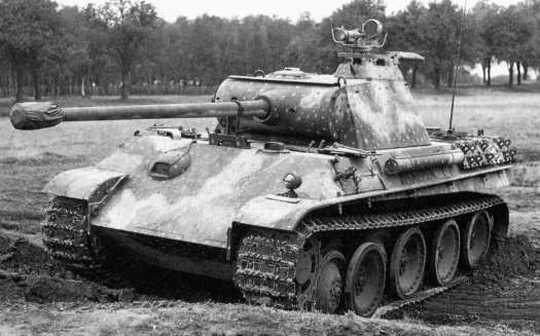
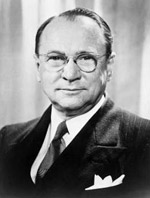 As seen in the photographs above, infrared night vision equipment was
already deployed on German PzKw Panther tanks as early as 1943, four
years before the Roswell incident.
As seen in the photographs above, infrared night vision equipment was
already deployed on German PzKw Panther tanks as early as 1943, four
years before the Roswell incident.
Wikipedia lists the development of night vision as follows: The first practical commercial night vision offered on the market was developed by Dr. V.K. Zworkin working for the Radio Corporation of America and was intended for civilian use. At that time infra-red was commonly called black light a term later restricted to Ultraviolet. It was not a success due to its size and cost. The first military night vision device was introduced by the German army as early as 1939. The first devices were being developed by AEG (a German company) starting in 1935. By the end of World War II, the German army had equipped approximately 50 Panther tanks, which saw combat on both the Eastern and Western Fronts.
Fiber Optics
The actual development path of fiber optics (or the guiding of light by refraction) dates all the way back to 1842 with Daniel Colladon in Paris. Practical application of the technology became a reality with the invention of the Photophone by Alexander Graham Bell on June 3, 1880. Bell would later comment that it was this invention rather than the telephone that was his greatest achievement. The device allowed for the transmission of both articulated sounds and normal human conversations on a beam of light (forerunner of today’s modern fiber optics networks).
Lasers and Particle accelerators
As far back as 1917, none other than Albert Einstein established the theoretical foundations for the laser in a technical paper titled: On the quantum theory of radiation. In addition, a Nazi document reproduced above highlights the work of Rolf Wideroe who was a Norwegian. He studied in Germany during the late 1920’s, and developed a radio resonance particle accelerator or “ray transformer”. However, the big bombshell with regard to a German connection to laser technology came from author and researcher Igor Witkowsky in his English translate version of The Truth about the Wunderwaffe. In the book, Witkowski reproduces a Nazi document which makes reference to the “Cascade Principle” in connection with an installation “for the manufacture of high voltage and large current intensity”. This is significant because as Dr. Farrell points out, “the Cascade Principle” is the very principle that lasers employ to cohere light into a non-divergent beam”.
Transistors and Integrated Circuits
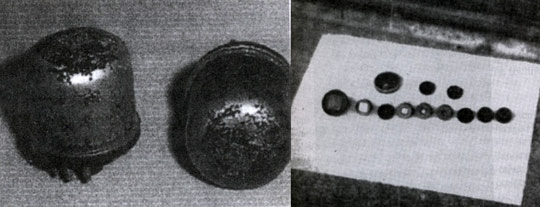 Also included in Corso’s list of “extraterrestrial debris” recovered
from the Roswell incident are the “micro-miniaturization of logic
boards” and integrated circuits. However, as the above photograph shows,
micro sized transistors were already in production as early as
1940-1941 by the Telefunken Company. As Dr. Farrell points out, this
particular Klystron tube is about the size of the last knuckle on a
human’s little finger. However, as Dr. Farrell points out, the British
and American equivalent of this tube at the end of the war was ten times
larger. Closely connected to transistor technology are semi-conductors.
However, once again as shown in the photo above taken by American
intelligence investigators after the war, German semi-conductors were
already in production.
Also included in Corso’s list of “extraterrestrial debris” recovered
from the Roswell incident are the “micro-miniaturization of logic
boards” and integrated circuits. However, as the above photograph shows,
micro sized transistors were already in production as early as
1940-1941 by the Telefunken Company. As Dr. Farrell points out, this
particular Klystron tube is about the size of the last knuckle on a
human’s little finger. However, as Dr. Farrell points out, the British
and American equivalent of this tube at the end of the war was ten times
larger. Closely connected to transistor technology are semi-conductors.
However, once again as shown in the photo above taken by American
intelligence investigators after the war, German semi-conductors were
already in production.
Instrumental in the design and construction of integrated circuits is the electron microscope. In 1931 German Physicist Ernst Ruska and Max Knoll (German electrical engineer) constructed the first electron microscope prototype which was capable of 400X magnification. Later in 1933, Ruka built the first electron microscope which was capable of exceeding the resolution of optical lens microscopes. Therefore, long before the end of the war, German technology had progressed far enough to make integrated circuits possible.
A close examination of just a few of the technologies which supposedly came from the Roswell extraterrestrial spacecraft indicates that they had a terrestrial based, and in most cases a German antecedent before 1947. The political and military implications of this finding should not be underestimated.
Debris origins and the Reich’s developments
The key to solving the Roswell case was, and has always been a correct determination of the origin of the wreckage. As stated earlier in this series, the debris was most certainly not American made due to the fact that it had been sitting on the New Mexico desert floor for the better part of four days. United States military commanders would never have allowed a secret experimental craft to remain exposed for any lengthy period of time. The chances of it being discovered by civilians or Russian spies would be too great. In addition descriptions of the material by eyewitnesses indicate that it was exotic, but not necessarily exotic enough to make it extraterrestrial. We will break down the material which was recovered, and examine its possible Third Reich origins. In addition, we will consider again Colonel Philip Corso’s “technology list”, and trace its development lineage.
Memory Metal
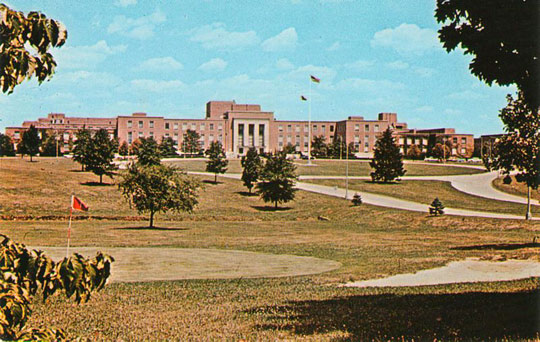
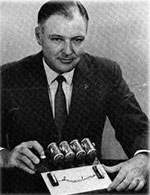 As highlighted in Roswell and the Reich (pg 458), there is a
metal which mimics the characteristics described by Roswell
eyewitnesses. The material known as “Nitinol” has super-elastic
properties under certain conditions of heat which allow it to return to
its original shape. It was discovered in 1962 by William Buehler and
Frederick Wang at the Naval Ordinance Laboratory. The material is
composed of nikel and titanium . However, as researchers are quick to
point out, Roswell occurred in 1947, fifteen years before the invention
of Nitinol in 1962. Without a documented development trail which
pre-dates Roswell, pro-extraterrestrial proponents would seem to have
won their case. Unfortunately, there is a development lineage that is
significantly earlier.
As highlighted in Roswell and the Reich (pg 458), there is a
metal which mimics the characteristics described by Roswell
eyewitnesses. The material known as “Nitinol” has super-elastic
properties under certain conditions of heat which allow it to return to
its original shape. It was discovered in 1962 by William Buehler and
Frederick Wang at the Naval Ordinance Laboratory. The material is
composed of nikel and titanium . However, as researchers are quick to
point out, Roswell occurred in 1947, fifteen years before the invention
of Nitinol in 1962. Without a documented development trail which
pre-dates Roswell, pro-extraterrestrial proponents would seem to have
won their case. Unfortunately, there is a development lineage that is
significantly earlier.
As highlighted in “Metals That Remember” Popular Science January 1988:
The effect called “mechanical recall”, was first observed by Swedish researcher Arne Olander in certain gold-cadmium alloys in 1932, Six years later, the effect was seen in certain copper-zinc brasses. But it didn’t really make a splash until 1962, when William Buehler of the U.S. Naval Ordinance Laboratory found that an alloy composed of equal parts of nickel and titanium exhibited the strange phenomenon.
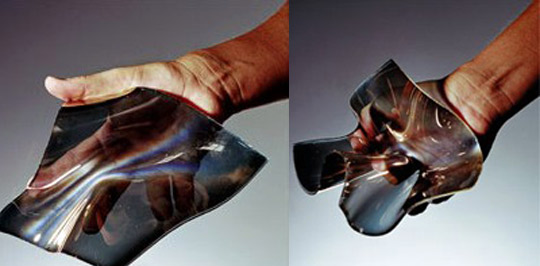 Therefore, there indeed was a development path for “shape memory
alloys” which dates all the way back to 1932, fifteen years before the
Roswell event ever happened. With the storm clouds of World War II just
over the horizon, the “memory metal” material would be of vital interest
to Nazi Germany. With enough funding, and access to experts in the
field of chemistry and metallurgy, shape memory alloys could have been
developed for secret aeronautical applications. The memory metal
characteristics of the Roswell debris as described by Mac Brazel, Major
Jesse Marcel and others, point to a history in Europe, and was most
likely a priority of the Third Reich.
Therefore, there indeed was a development path for “shape memory
alloys” which dates all the way back to 1932, fifteen years before the
Roswell event ever happened. With the storm clouds of World War II just
over the horizon, the “memory metal” material would be of vital interest
to Nazi Germany. With enough funding, and access to experts in the
field of chemistry and metallurgy, shape memory alloys could have been
developed for secret aeronautical applications. The memory metal
characteristics of the Roswell debris as described by Mac Brazel, Major
Jesse Marcel and others, point to a history in Europe, and was most
likely a priority of the Third Reich.
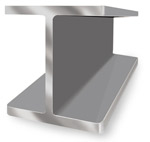 As highlighted in “Metals That Remember” Popular Science January 1988:
As highlighted in “Metals That Remember” Popular Science January 1988:
When Major Marcel arrived at home at 2:00 AM on the morning of Tuesday July eighth, he was exited to show his family. It was then that Marcel’s son Jesse Jr. discovered the “strange writing” on the so called “I-beams”. However, there appears to be a discrepancy with what was actually observed. While Jesse Marcel Jr. described seeing “I-beams”, Marcel Sr. described them as “solid members, square or with a rectangular cross section”. In addition, I-beams are susceptible to “load concentrations”. When a load is applied to an I-beam, cracks can develop on the inside corners causing a structural failure. To prevent this engineers utilize a small “fillet radius” on the four inside corners. These help to distribute the load, thereby minimizing the risk of a failure. Whether or not the actual Roswell I-beams incorporated this design feature has never been determined. However if they did, that would be a definite indicator of man-made technology. In addition, I-beams are composed of multiple 90 degree right angles which are very poor for stealth aircraft design. When radar waves hit these surfaces, they are reflected back to the origin point. To properly make an aircraft “stealthy” advanced composite materials are used in conjunction with “smooth continuous contouring” as utilized on the Northrop B-2 Stealth bomber. Would an alien spacecraft really be composed of multiple I-beams with their very un-stealthy characteristics?
We also need to address the strange “hieroglyphic writing” that was described by Jesse Marcel Jr. These writings or symbols have so far, remained “undeciphered”. However, they may have been connected to a possible field propulsion system on-board the craft which was designed by Richter and Debus as described earlier in this series. However, what if the symbols represented not a language, but conceptual ideograms, or more simply mathematical equations? Recall in an earlier segment of this series that witnesses described seeing symbols (which resembled “flowers”) that had “numbers arranged in columns” next to them. Brazel’s son Bill described the strange characters as looking like “southwestern American Indian petroglyphs”. Farrell points out that physicist Anthony Peratt noticed the strong resemblance of the “stick man” petroglyphs to the types of “plasma pinch” effects he was observing in his laboratory. Could the strange symbols on the Roswell I-beams have actually represented a sort of “pre-ignition checklist” of some sort? Could the purple and pink colored “flowers” on some of the debris have been related to the operation of an on-board field propulsion system?
In addition, Bessie Brazel’s description of “flowers” with “numbers in columns” bears a striking resemblance to electron cloud probability distribution charts. To the untrained eye, these could have been mistaken as “alien writing” on the debris recovered from the Foster ranch. Could the strange symbols actually have been part of a “firing sequence” associated with ignition of a “torsion physics” plasma field propulsion system?
Super strong metals
Reference Major Jesse Marcel’s comments that some of the Roswell debris included “tin-foil” like metal which was extremely light, but could not be dented with a sledgehammer. Was the Third Reich involved in the development of such a material? According to author and researcher Henry Stevens, they were. In Hitler’s suppressed and still secret Weapons science and Technology, Stevens highlights a letter he received which described a super-hard metal known as “Impervium”:
“In Schramberg, South Bavaria, I had a friend whose father was a renowned metallurgy scientist. He experimented with the chemistry of metals. There is little doubt that he was one of the world’s most brilliant minds, for it was this same scientist who invented a metal harder than diamonds. In 1935-1936, the Nazis put this amazing metal, we shall call it IMPERVIUM to use for the first time in airplanes of the German Air Force”.
So, what do we have here? A reference to a metal with unique properties which is “harder than diamonds”, and employed on German aircraft in 1936 (eleven years before the Roswell incident). Now, the claim could be made that this was just an anonymous letter with no evidence to back it up. However, skeptics would do well to consider a British Intelligence Objectives Sub-Committee report which highlights an important advancement in German metallurgy. In report number 142, Joseph Ernst claimed that the Germans had developed a method to harden steel and aluminum beyond any means yet developed. The very same report also stated that the weight of aircraft structures could be reduced by up to 50% using this technique. He claimed that this involved a process of nitrogen bonding to the surface of these metals. Ernst went on to state that all of the equipment associated with this metal hardening process was stored at a facility in Weilheim, near Munich.
Porous Metal
In addition to material which “could not be dented with a sledgehammer”, Major Marcel also stated that some of the Roswell wreckage included material that you could “blow through”. What might the significance of this be? In the field of aeronautical engineering, two significant “holy grails” have been identified: 1) anti-gravity, 2) Laminar Flow Control. In simple terms, as the air-flow progresses across the wing’s upper surface, it eventually becomes “detached”, which causes turbulent flow and a decrease in efficiency. If a method could be developed to keep the air-flow “attached” much further aft of the leading edge, tremendous decreases in drag could be obtained. This would involve putting thousands of tiny micro-porous holes on the wing’s upper surface. Was the Third Reich developing such a technology before the close of World War II? According to author W.A. Harbinson, they were. In his book Project UFO Harbinson describes an aircraft under development in Germany which would be devoid of all obstructing protuberances such as wings, rudders, and air-intakes. Indeed, Harbinson is proposing to delete conventional wings altogether, and incorporate a circular or saucer shaped aircraft design which would utilize a lightweight engine in the center. In this configuration, the entire exterior surface or “skin” could be used to “suck in the boundary layer”. Harbinson continuous by stating that: “if a craft could be built with a porous metal that would act like a sponge and remove the need for air-intakes altogether, it would result in frictionless airflow during flight”. Is there any evidence for the development of this porous metal in Nazi Germany?
The concept of laminar flow control by means of suction through tiny holes evenly distributed over a wing’s surface indeed does have merit. Speaking at the 34th Wilbur Wright Memorial Lecture held on May 30, 1946 British aerodynamics expert Professor E.F. Relf, stated that research in this field was conducted by the National Physics Laboratory. In December of the same year, Sir Ben Lockspeiser when commenting on the future of British aeronautics stated an aircraft using this technology could “slip through the air in the same way as a piece of wet soap slips through the fingers”. Such a porous was indeed under development by the Zepplin works at Friedrichschafen. The material consisted of various compounds of magnesium and aluminum. It was permeated with microscopic holes, and was known as Luftschwamm or aerosponge. According to author Renato Vesco, Luftschwamm could withstand temperatures of up to 1,000 degrees Centigrade. Was the material which could be “blown through” reported by Major Jesse Marcel a pre-wartime development of Germany?
A close examination of the debris recovered from the Roswell crash reveals a man-made German origin. In almost every case from the so called “memory metal”, to the super-strong material which were described by Roswell witnesses, a German antecedent can be identified before 1947.
The Nazi Connection
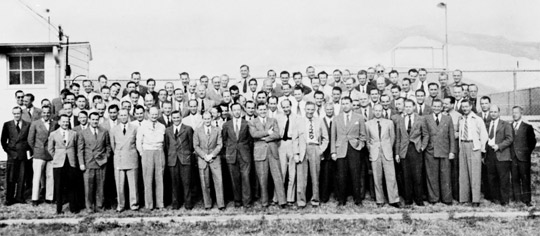 It’s a well established historical fact that after the war, a large
number of Nazi scientists and engineers were brought to America under
Operation Paperclip. Many of these engineers had their former Nazi war
criminal records scrubbed clean in exchange for political immunity. One
of the high ranking generals who oversaw the operation was General Hoyt
Vandenberg who was curiously later alleged to be a member of “MJ-12”. In
cases where no amount of sanitizing could wash someone’s Nazi record
clean, these individuals were relocated to Argentina. Concurrently
however with Operation Paperclip, a secret program code-named
“Safehaven” was also being implemented behind the scenes. According to
author Linda Hunt in her book Secret Agenda (page 26) its
stated purpose “was designed to prevent Germans from escaping to other
countries, primarily in Latin America, to continue their wartime
research.” Therefore, we appear to have two opposing programs running at
the same time. One designed to help Nazi’s integrate into the American
defense industry, and one to prevent the formation of a separate an
independent “Nazi International” and their subsequent postwar military
research. The actions of the United States government immediately after
the war clearly indicate that they suspected that such an organization
already existed. What do the actions of former Nazis in Argentina have
to do with the Roswell incident? It’s important that we “lay the
foundation”, and “build the case”, so that we can get a detailed
historical perspective of events which immediately followed World War
II.
It’s a well established historical fact that after the war, a large
number of Nazi scientists and engineers were brought to America under
Operation Paperclip. Many of these engineers had their former Nazi war
criminal records scrubbed clean in exchange for political immunity. One
of the high ranking generals who oversaw the operation was General Hoyt
Vandenberg who was curiously later alleged to be a member of “MJ-12”. In
cases where no amount of sanitizing could wash someone’s Nazi record
clean, these individuals were relocated to Argentina. Concurrently
however with Operation Paperclip, a secret program code-named
“Safehaven” was also being implemented behind the scenes. According to
author Linda Hunt in her book Secret Agenda (page 26) its
stated purpose “was designed to prevent Germans from escaping to other
countries, primarily in Latin America, to continue their wartime
research.” Therefore, we appear to have two opposing programs running at
the same time. One designed to help Nazi’s integrate into the American
defense industry, and one to prevent the formation of a separate an
independent “Nazi International” and their subsequent postwar military
research. The actions of the United States government immediately after
the war clearly indicate that they suspected that such an organization
already existed. What do the actions of former Nazis in Argentina have
to do with the Roswell incident? It’s important that we “lay the
foundation”, and “build the case”, so that we can get a detailed
historical perspective of events which immediately followed World War
II.
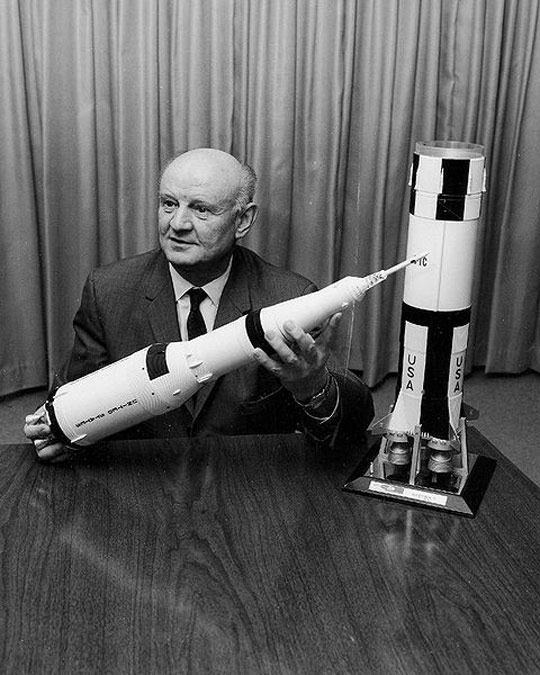 The penetration of former Nazi’s into the American space program and
military industrial complex is also a well established fact. For
example, Nazi chemical warfare experts were soon found working for the
Rockefeller Institute and working at Wright Field (Dayton Ohio) on
supersonic aircraft designs. In fact, Kurt Debus became launch director
at NASA’s Cape Canaveral (later named the Kennedy Space Center). In
addition, the designer of the booster stage for the massive Saturn V
moon rocket was none other than Arthur Rudolph. Incredibly, as Linda
Hunt explains, Under Secretary of War Robert Patterson stated “these men
are enemies, and it must be assumed that they are capable of sabotaging
our war effort”. As one American counter-intelligence officer noted,
Arthur Rudolph’s Paperclip file indicated that he was “100% Nazi”, and
was a “dangerous type”. Curiously, after the completion of the Apollo
program, Rudolph fled the country under threat from the U.S. Justice
Department for indictment of war crimes. This “turning of the cheek” and
utilization of former Nazi war criminals for military gain represents
America’s “dirty little secret” with all of its ongoing politically
explosive implications.
The penetration of former Nazi’s into the American space program and
military industrial complex is also a well established fact. For
example, Nazi chemical warfare experts were soon found working for the
Rockefeller Institute and working at Wright Field (Dayton Ohio) on
supersonic aircraft designs. In fact, Kurt Debus became launch director
at NASA’s Cape Canaveral (later named the Kennedy Space Center). In
addition, the designer of the booster stage for the massive Saturn V
moon rocket was none other than Arthur Rudolph. Incredibly, as Linda
Hunt explains, Under Secretary of War Robert Patterson stated “these men
are enemies, and it must be assumed that they are capable of sabotaging
our war effort”. As one American counter-intelligence officer noted,
Arthur Rudolph’s Paperclip file indicated that he was “100% Nazi”, and
was a “dangerous type”. Curiously, after the completion of the Apollo
program, Rudolph fled the country under threat from the U.S. Justice
Department for indictment of war crimes. This “turning of the cheek” and
utilization of former Nazi war criminals for military gain represents
America’s “dirty little secret” with all of its ongoing politically
explosive implications.
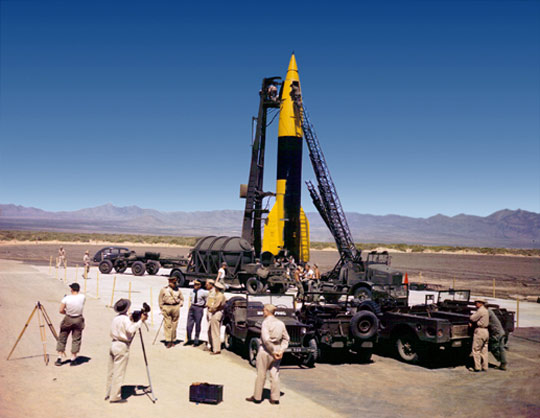 However, these “back door” deals pale into insignificance when
compared to the shenanigans that went on at Fort Bliss, and specifically
the White Sands Missile Range (then known as White Sands Proving
Ground). Since America had little or no experience with rockets
immediately after the war, former Nazi’s who were brought to Fort Bliss
TX were given 100% full authority with respect to the launch procedures
of captured German V-2 rockets. Supervising the launches was a top
rocket scientist by the name of Ernst Steinhoff who was a former member
of Werner von Braun’s team back in Peenemunde. He had the authority to
abort launches, and to blow up rockets in mid-air if something went
wrong. At the launch site, various teams were strategically positioned
to monitor the flight with high powered telescopes in an effort to
ensure that the rocket did not divert from its intended course. What
happened next is detailed on page 42 of Secret Agenda. Shortly after the launch of the launch, the V-2:
However, these “back door” deals pale into insignificance when
compared to the shenanigans that went on at Fort Bliss, and specifically
the White Sands Missile Range (then known as White Sands Proving
Ground). Since America had little or no experience with rockets
immediately after the war, former Nazi’s who were brought to Fort Bliss
TX were given 100% full authority with respect to the launch procedures
of captured German V-2 rockets. Supervising the launches was a top
rocket scientist by the name of Ernst Steinhoff who was a former member
of Werner von Braun’s team back in Peenemunde. He had the authority to
abort launches, and to blow up rockets in mid-air if something went
wrong. At the launch site, various teams were strategically positioned
to monitor the flight with high powered telescopes in an effort to
ensure that the rocket did not divert from its intended course. What
happened next is detailed on page 42 of Secret Agenda. Shortly after the launch of the launch, the V-2:
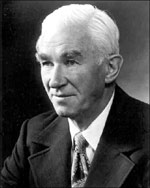 “began to go astray, reverse course, and head straight south toward
El Paso. Steinnhoff knew the rocket was headed in the wrong direction
but let it fly. It soared over El Paso, over the Mexican border, and
finally crash-landed about three miles from a heavily populated Juarez
business district. Mexican residents nearby fled in terror as the rocket
exploded, leaving a huge crater fifty feet wide, and 24 feet deep as it
burrowed into the ground. The next day, red-faced officials in
Washington had to explain to the Mexican government why the United
States had launched a missile attack on their country.” (this incident
took place on May 29, 1947)
“began to go astray, reverse course, and head straight south toward
El Paso. Steinnhoff knew the rocket was headed in the wrong direction
but let it fly. It soared over El Paso, over the Mexican border, and
finally crash-landed about three miles from a heavily populated Juarez
business district. Mexican residents nearby fled in terror as the rocket
exploded, leaving a huge crater fifty feet wide, and 24 feet deep as it
burrowed into the ground. The next day, red-faced officials in
Washington had to explain to the Mexican government why the United
States had launched a missile attack on their country.” (this incident
took place on May 29, 1947)
Now, the big question that needs to be asked is why did Steinnhoff not abort the launch, and allow the rocket to continue towards El Paso? This raises the possibility that his actions were deliberate. An interesting point to keep in mind is that former Nazi rocket scientists working for the United States Army at Fort Bliss had virtually no surveillance, and could easily cross the border into northern Mexico at will. In addition, it was discovered that three of the Nazi scientists had illegal mail drops in El Paso where they received money from foreign sources, and coded messages from South America. As Dr. Joseph Farrell points out in Roswell and the Reich, Neither Army counterintelligence or FBI agents knew where the money came from, and by all appearances, nobody cared to know how more than a third of the Paperclip scientists were suddenly able to buy expensive cars. Certainly the modest salary provided by the United States government would never have been enough to cover multiple trips into Mexico, or the cost of a new Mercedes.
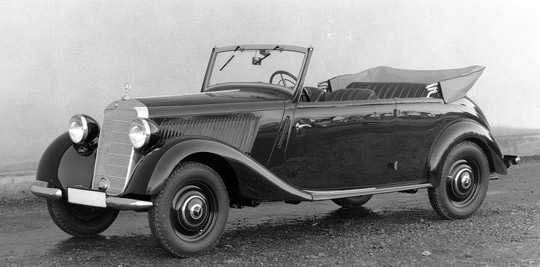 Stranger still, is the fact that this launch failure was not an isolated incident. As Hunt reveals:
Stranger still, is the fact that this launch failure was not an isolated incident. As Hunt reveals:
Base security officers began to suspect that the rockets were being sabotaged, a suspicion that increased sharply after the Juarez incident. In one month, three out of four rockets fired at the White Sands Proving Ground overshot the 90 mile wide base, and landed off course near heavily populated areas in New Mexico and Juarez. One landed four and a half miles south of Alamorgordo, another crashed only two miles from Las Cruces, and the third ended up in Juarez. In addition to unanswered questions about what caused the erratic flights, five cameras attached to one of the rockets were missing after the launch, and parts from another missile that was launched were never found. (Secret Agenda pp 50-51)
With the practically non-existent monitoring of these scientists, and their “free reign” of launch control operations, the possibility of sabotage should not be underestimated. With the combination of “failed launches”, and missing cameras which could have snapped pictures of America’s sensitive military installations, these V-2 flights could have served as intelligence gathering surveillance missions for their Nazi counterparts back in Argentina.
As stated earlier, Argentina was the postwar headquarters of a large compound of Nazis (specifically the town of San Carlos de Bariloche). Before the end the war, the Nazis turned over control of their large radio transmitter network (the Bolivar network) based throughout Latin America to the Argentine leaders. Such a move would allow a postwar independent “Nazi International” to transmit messages to, and receive messages from their Paperclip comrades working at White Sands Proving Ground in New Mexico. In a future installment of this series, we will expand on the Nazi connection to the Roswell incident.
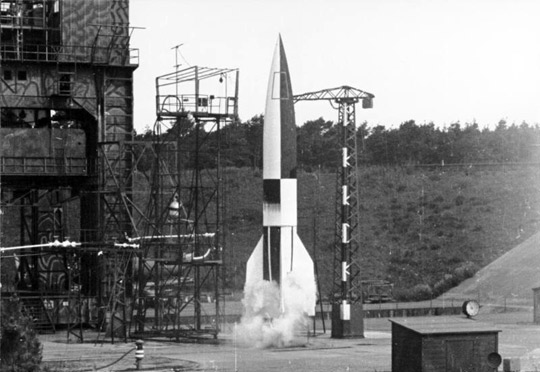 The logistical similarities between NASA’s Kennedy Space Center and
the advanced German aerospace research facility at Peenemunde should not
go unnoticed. The famous “5-4-3-2-1” countdown made so famous during
American Apollo moon missions was originally a German invention. In
fact, the organization that the Germans established at NASA’s Marshall
Space Flight Center in Huntsville Alabama was essentially an exact copy
to the one in Peenemunde. In addition, the Germans dominated America’s
space program so much that they held key positions within the
organization:
The logistical similarities between NASA’s Kennedy Space Center and
the advanced German aerospace research facility at Peenemunde should not
go unnoticed. The famous “5-4-3-2-1” countdown made so famous during
American Apollo moon missions was originally a German invention. In
fact, the organization that the Germans established at NASA’s Marshall
Space Flight Center in Huntsville Alabama was essentially an exact copy
to the one in Peenemunde. In addition, the Germans dominated America’s
space program so much that they held key positions within the
organization:
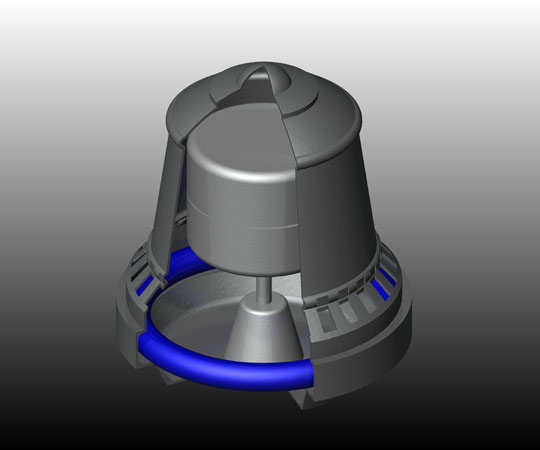 Since America’s space program was dominated by former Nazi rocket
scientists, why would Kurt Debus be chosen as launch control director of
the Kennedy Space Center when his area of expertise was never in the
field of rocketry? Debus excelled in the field of high voltage direct
current electrical discharge physics and measurement. In addition, why
was Debus’ security clearance re-examined after he arrived at Fort Bliss
TX under Operation Paperclip? Did American intelligence officials
suspect there was something more going on with Debus than previously
thought? Stranger still is the fact that on the day of the Roswell
incident, Debus was in New Mexico (specifically White Sands Proving
Ground). In fact, Debus worked on a project measuring high voltage
discharges in plasma during 1942-1943 when he worked for AEG. With a
post-war “Nazi International” already set up in Argentina, we can now
turn our attention to the advanced controlled fusion projects of Nazi
scientist Ronald Richter. His experiments took place on Huemul Island
near San Carlos de Bariloche. As Farrell points out in Roswell and the Reich,
it was Richter’s opinion that quasi-fusion or full fledged processes
taking place within a rotating plasma under conditions of extreme
electrical stress were a potential gateway technology to be able to tap
into and transduce the zero point energy field. Curiously, the United
States Air Force took an interest in Richter’s work, and quietly
investigated him four years after the program was shut down in 1952. A
closer examination of Richter’s work reveals its obvious ties to Nazi
Germany’s most advanced secret weapons research program, “The Bell”. It
was known that The Bell was a hyper dimensional torsion-based gateway
technology that the Nazis had developed to investigate its potential
applications in three areas:
Since America’s space program was dominated by former Nazi rocket
scientists, why would Kurt Debus be chosen as launch control director of
the Kennedy Space Center when his area of expertise was never in the
field of rocketry? Debus excelled in the field of high voltage direct
current electrical discharge physics and measurement. In addition, why
was Debus’ security clearance re-examined after he arrived at Fort Bliss
TX under Operation Paperclip? Did American intelligence officials
suspect there was something more going on with Debus than previously
thought? Stranger still is the fact that on the day of the Roswell
incident, Debus was in New Mexico (specifically White Sands Proving
Ground). In fact, Debus worked on a project measuring high voltage
discharges in plasma during 1942-1943 when he worked for AEG. With a
post-war “Nazi International” already set up in Argentina, we can now
turn our attention to the advanced controlled fusion projects of Nazi
scientist Ronald Richter. His experiments took place on Huemul Island
near San Carlos de Bariloche. As Farrell points out in Roswell and the Reich,
it was Richter’s opinion that quasi-fusion or full fledged processes
taking place within a rotating plasma under conditions of extreme
electrical stress were a potential gateway technology to be able to tap
into and transduce the zero point energy field. Curiously, the United
States Air Force took an interest in Richter’s work, and quietly
investigated him four years after the program was shut down in 1952. A
closer examination of Richter’s work reveals its obvious ties to Nazi
Germany’s most advanced secret weapons research program, “The Bell”. It
was known that The Bell was a hyper dimensional torsion-based gateway
technology that the Nazis had developed to investigate its potential
applications in three areas:
1) As a means to tap into the zero-point energy field
2) As a means to manipulate gravity itself (field propulsion technology)
3) As a means to the ultimate, potentially planet-busting weapon
The key to achieving these goals was the manipulation of rotating magnetic fields by means of the counter-rotation of a plasma within the device itself (similar to the rotating Mercury plasma vortex engines employed on the “Vimannas” of ancient India). However, Richter’s connection to the Bell project was significantly more involved. He worked in Nazi Germany on a highly classified program code-named “Charite-Anlage” which was the exact code-name for the Bell device. Therefore, there is every reason to suspect that a completely separate Nazi organization was using Argentina as a base of operations to continue their advanced research associated with technologies of the Bell. Also reference in part seven of this series, that traces of radiation were found at the Roswell impact site. It is known that the Bell used Uranium and Thorium as a part of its propulsion system.
Now, we turn our attention back to Col. Corso, and his description of how the alleged Roswell “alien” spacecraft actually flew:
“The craft was able to displace gravity through the propagation of magnetic waves, controlled by shifting the magnetic poles around the craft so as to control, or vector, not a propulsion system but the repulsive force of like charges. Once they realized this, engineers at our country’s primary defense contractors raced among themselves to figure out how the craft could retain its electrical capacity and how the pilots who navigated it could live within the energy field of a wave”. – The Day After Roswell p. 100
As an interesting “coincidence”, one of the principle Nazi scientists involved with the Bell program who also came to America under Operation Paperclip, turned out to be none other Dr. Kurt Debus. He worked in conjunction with Richter, and proposed the concept of “magnetic field separation” as a means of creating a coupling effect between magnetism and gravity via magnetic waves. Is it merely a just “coincidence” that Corso’s “propagation of magnetic waves” as proposed in the Roswell craft mirrors that of the “counter-rotation of a plasma” within the propulsion system utilized in the Bell? Is it possible that Debus was involved in a secret program which took place before the end of the war to build a craft which could overfly American military installations based off his work with Richter? Did this craft utilize a propulsion system which was based off of the technology developed from the Bell program? As is universally accepted, the Roswell incident took place on the night of July 3, 1947 (during an intense thunderstorm). Could the associated lightning have caused an “arc” within such a flying craft that utilized rotating pulsed plasma in conjunction with high voltage direct current electricity? This would explain the strange “boom” heard by rancher Mac Brazel who commented that it was distinctly different than the background noise of the thunderstorm.
To make our case even stronger, reference the literally hundreds of reports of “flying saucers” in the months proceeding July of 1947. Newspaper articles from that time-frame indicate that these unusual vehicles were travelling around 1,200 mph, far too slow to be an inter-stellar craft. In addition, Lt Colonel Moncel Monts, indicated that the immediate post-war policy of the United States Army Air Force was to “shoot them down” if they could not be talked down. Are we to believe that United States Generals thought American pilots could talk to “aliens”, or were the flying saucers being piloted by a secretive, but very terrestrial based organization? This “shoot down” order would ultimately have to come directly from president Truman himself. However, in doing so, he risked an interplanetary war with a race of beings which could potentially be millions of years ahead of our own. This leads to the conclusion that Truman knew all along through his scientific and military advisors that some of the objects were of terrestrial origin. Therefore, based on a detailed analysis of the wreckage that was recovered on the Foster Ranch, and the political movements of the Third Reich after the war, we can come to the following assessment: The Roswell craft that crashed on the night of July 3, 1947 was the product of a post-war independent “Nazi International” organization based out of Argentina. Using advanced technologies developed by Kurt Debus and Ronald Richter this vehicle could fly non-stop all the way to New Mexico. Utilizing advanced metals and the lack of a conventional “engine” the craft was decades ahead of anything America was building at the time. Therefore, the associated cover-up was not so much that “aliens are here” but that a post-war independent Nazi organization indeed did exist, which developed a propulsion system based on advanced torsion field physics. This of course proved to be too embarrassing for the United States government to acknowledge with all of its potentially explosive political and military implications.
Note: The opinions expressed by the author do not necessarily reflect the opinions of the staff of Open Minds Production.

Roswell Daily Record July 8, 1947.
Of all the historically significant political/military events of the 20th Century, none have had more official explanations than the so called “Roswell incident”. In fact, as of 2011, the United States government has issued four sanctioned explanations: 1) The crash of a flying saucer, 2) the remains of a weather balloon, 3) the remains of a Project Mogul balloon, 4) Crash test dummies. Logic alone would dictate that if the government lied about the last three explanations, why should the general public believe the first one? A closer examination of the original Roswell Daily Record of July 8, 1947 reveals some interesting details which were there all along.

Roswell Daily Record July 9, 1947.
Within the test of the Roswell Daily Record article, no detailed descriptions of the debris are present, and as Kal Korff highlighted on page 27 of his publication The Roswell UFO Crash:
“Unfortunately, a careful reading of Moore and Berlitz’s Roswell Incident reveals that despite the impressive claim of having “interviewed more than seventy witnesses”, the testimonies of just twenty-five people are presented. Out of these twenty-five, only seven of them are firsthand sources who claim to have seen the alleged saucer debris, and one of these suspect. Of these seven people however, only five of them claim to have actually handled the material personally, and one of them is adamant that it was not from an extraterrestrial spacecraft”.
Examining the debris

Dr. Alexander Lippisch

Left: Kenneth Arnold with an illustration of a UFO he saw in 1947. Right: Illustration of a flying wing.

Roswell I-Beam illustration by Michael Schratt.
1) Beams made of a balsa wood like material.
a) were approximately ½” square
b) had “hieroglyphic” symbols
c) were flexible but not breakable
d) would not burn
2) Parchment like material
a) brown in color
b) extremely strong
c) could not be burned
d) included numbers with pink and purple hieroglyphic symbols
e) the symbols appeared to be painted on
3) Tin foil like metal
a) very thin, resembling the foil used in a pack of cigarettes
b) could not be dented, even with a sixteen pound sledgehammer
c) could not be cut
d) extremely light
e) was flexible, but would not crease (memory metal)
4) A mysterious metallic looking “black box”
a) several inches square
b) very light
c) could not be opened
Now, it’s important to keep in mind that after closely examining the debris seen by Major Jesse Marcel, we can conclude that indeed, the material was exotic, but not necessarily exotic enough to make it extraterrestrial. Note that Marcel stated that he saw numbers on the parchment like material near the hieroglyphic symbols. How could Marcel have possibly identified numbers on the debris, unless they were an adaptation of standard Arabic or Roman numerals? It’s highly unlikely that he could have deciphered the writing from an “alien” culture. This one point strongly suggests the terrestrial origin for the debris.
Another key figure in the Roswell account is William “Mac” Brazel. Although being the first to discover the debris, he died before researchers were able to track him down for comment. Fortunately, his son Bill was still alive, and was interviewed by co-author William Moore in 1979. Bill mentioned that even after the military had cleaned up the debris field, he was still able to find small pieces of wreckage after heavy rain-fall. After approximately two years, he was able to accumulate enough to fill a small cigar box. Bill described picking up some very light wooden-like particles. The material was pliable, but could not be broken or scratched. He also described seeing a dark tin foil like material which could not be torn. It was very lightweight, and could not be creased. As Bill states: “the odd thing about this foil, was that you could wrinkle it, and lay it back down, and it immediately resumed its original shape”. This is of course a reference to the famed “memory metal” described by multiple Roswell eyewitnesses. He also described some thread-like material that resembled silk. Bill also recalled that there was no writing on the material he recovered. Unfortunately, Bill’s small collection of debris was ultimately confiscated by the United States Army making an independent analysis of the wreckage impossible. Bill’s description of the debris closely matches that of Marcel, and he also stated that his father “Mac” never saw any bodies or creatures associate with the wreckage. As stated earlier, the debris may indeed have been exotic, but not necessary exotic enough to make it extraterrestrial in origin. Floyd Proctor (Mac Brazel’s neighbor) recalls that one day Mac came over to his house talking about debris that he had found on the ranch that had “designs on it that reminded him of Chinese and Japanese designs…..like the kind of stuff you would find on firecracker wrappers”. These descriptions of writing on the Roswell wreckage don’t automatically infer an extraterrestrial origin, and any claims that these were the work of “aliens” is pure speculation at best.

Col. William Blanchard
Claims of “alien” bodies re-examined

From uper left, clockwise: Glenn Dennis, Frank Kaufmann, Jim Ragsdale, William "Mac" Brazil, Gerald Anderson, Barney Barnett.
Glenn Dennis: The Roswell mortician who claimed knowledge of the bodies from his “nurse friend” known as “Mary Naomi Self” who was present during an alleged autopsy at the base hospital. According to Dennis, she was believed to have later crashed in an airplane accident. Dennis claimed that the nurse in question made a rough drawing of the “aliens” that she allegedly saw at the base hospital. Curiously though, this original sketch was somehow “lost”. After an exhaustive search of military records pertaining to a nurse at Roswell by the name of “Mary Naomi Self”, no records could be found. After cross examination, Dennis later admitted that he lied to Roswell researchers about her actual identity. The fact that Dennis lied to researchers automatically impeaches his testimony. In addition, the fact that the nurse (if she actually ever existed) died in an aircraft accident makes the descriptions of the alleged alien bodies by her second-hand dead person’s testimony.
Frank Kaufmann: Claimed that he not only was part of the Roswell crash/retrieval operation, but that he actually saw two bodies as well. After his death, Roswell researchers were given access to his personal files by his widow Juanita Kaufmann. When looking through the material, researchers found “cut and paste” forged documents relating to his military background which thereby impeaches his testimony. Specifically, Kaufmann’s SQR (Separation Qualification Record) showed signs of discoloration from the rubber cement used to fake the document. In addition, an Underwood typewriter of World War II vintage was discovered. When characters from that typewriter were compared to proven counterfeit documents, they were an exact match. Researchers also discovered that he was never listed in the Roswell Army Air Field yearbook of 1947.
Jim Ragsdale: Totally discredited by Roswell researchers. Changed his story multiple times, and even claimed to have recovered “golden helmets” from the dead crew of the craft.
Barney Barnett: Second-hand dead man’s testimony. Barnett claimed to have seen a crashed saucer with alien bodies in the “Plains of San Augustin” sometime during the late 1940’s. He provided no corroborating witnesses to his story. Claimed that the crash site was actually 150 west of the Foster ranch, making it much too far away to have any military involvement from Roswell Army Air Field. Roswell researchers uncovered Ruth Barnett’s diary which showed that her husband was home in Socorro NM during early July of 1947, and could not have been in the vicinity of the crash site as first proposed in The Roswell Incident.
Gerald Anderson: No longer credible according to Roswell researchers. First came to light after the TV series Unsolved Mysteries did a segment on Roswell which aired in January of 1990. Claimed to have seen wreckage and four “creatures” (three dead, and one still alive), but was only six years old at the time of the alleged incident. Changed his story multiple times, and admitted to falsifying documents. Statements from Anderson’s cousin indicate that an alleged original “journal” of the crash, and “wreckage” were apparently buried “out there”. However, this alleged smoking gun evidence has never been found.
William “Mac” Brazel: Although Mac Brazel was certainly a respectable rancher, Roswell researches never questioned him before he died in 1963. Therefore, statements regarding Mac’s descriptions of “unfortunate little creatures” which originated from Roswell radio station board man Frank Joyce represent second-hand dead man’s testimony. In addition, Brazel never gave any detailed descriptions of the bodies other than to say that they “weren’t green”.
From the shaky and unsubstantiated testimony of the above “eyewitnesses”, a very weak case can be made that the so called Roswell bodies were extraterrestrial in origin. In fact, the alleged “nurse” mentioned by Glenn Dennis described the bodies as having the following traits:
1) looked like ancient Chinese
2) were small and fragile
3) had no hair
4) their noses did not protrude
5) the eyes were set deep in the heads
6) the ears were little indentations
7) their upper arms were longer than their lower arms
8) they had no thumbs, and only for fingers
9) had large heads out of proportion to the rest of the body
10) small stature, that of “ten year old children” between four to five feet in height
While it can be argued that the above traits are unusual, to say that they represented anything extraterrestrial is a huge leap in interpretation, and cannot be conclusively proven by any of the so called “star witnesses” involved in the Roswell incident.
The Corso Connection

The Day After Roswell book cover.
In addition, the testimony of 1st Lt. Chester Barton should not go unnoticed. Interviewed by researcher Joseph Stefula, Lt. Barton was a crypto specialist with the 509th communications unit. He was ordered to the crash site personally by RAAF Provost Marshal Major Edwin Easley. Upon arrival, Baron recalled seeing the extreme level of security associated with the crash. He also remembered seeing an impact site with at least three large burned areas. Although he never got closer than fifty yards from the wreckage, Barton was certain that what he saw had absolutely nothing to do with a weather balloon. Since there were MP’s with Geiger-counters stationed around the crash site, he originally thought it was the remains of a B-29 that had crashed carrying an atomic bomb. Low levels of radiation were detected at the impact site (this would immediately rule out a weather balloon). Note that Lt. Barton never mentioned anything about an extraterrestrial spacecraft, only that the remains resembled that of a crashed aircraft. However, an exhaustive search of Army Air Force records indicated that there were no aircraft crashes in that vicinity during the time of the incident. He also mentioned that there were no signs of any propellers or engines. This leads to the strong possibility that what crashed was certainly terrestrial in origin, but not necessarily American made.

Col. Phillip J. Corso
“to use the Army’s ongoing weapons development and research program as a way to filter the Roswell technology into the mainstream of industrial development through the military defense contracting program. Today, items such as lasers, integrated circuitry, fiber optics networks, accelerated particle-beam devices, and even the Kevlar material used in bulletproof vests are all commonplace. Yet the seeds for the development of all of them were found in the crash of the alien craft at Roswell and turned up in my files fourteen years later”.
Corso also maintains that all the from the Roswell incident were stored in his office in a single locked filing cabinet which also included some of the actual debris. However, when reviewing the underlying premise of Corso’s book, two red flags immediately present themselves: 1) as nuclear physicist and Roswell researcher Stanton Friedman points out, why would the U.S. Army entrust the analysis and reverse-engineering of a recovered extraterrestrial craft and its technologies to a (then) mere lieutenant colonel with absolutely no engineering or scientific background? 2) By his own admission, even Corso’s own son Philip J Corso Jr. pointed out that the book was ninety percent pure fabrication as highlighted in Kevin Randle’s publication Roswell Revisited pp. 118-119.
Corso maintains on page 115 of his book that the following technologies owe their existence to the Roswell incident:
1) Image intensifiers, which ultimately became “night vision”
2) Fiber optics
3) Supertenacity fibers
4) Lasers
5) Molecular aligned metallic alloys
6) Integrated circuits and microminiaturization of logic boards
7) HARP (High Altitude Research Project)
8) Project Horizon (moon base)
9) Portable atomic generators (ion propulsion drive)
10) Irradiated Food
11) “Third Brain” guidance systems (EBE headbands)
12) Particle beams (“Star Wars” antimissile energy weapons)
13) Electromagnetic propulsion systems
14) Depleted uranium projectiles
However, do these technologies represent something that originated “off world”, or could they have been designed and developed by a very terrestrial (yet high tech) organization? However, on page four of his book, Corso suspects that the Roswell technology resembled that of the Nazi’s during the war:
“In those confusing hours after the discovery of the crashed Roswell alien craft, the Army determined that in the absence of any other information, it had to be extraterrestrial. Worse, the fact that this craft and other flying saucers had been surveying our defensive installations and even seemed to evidence a technology we’d seen evidenced by the Nazi’s caused the military to assume these flying saucers had hostile intentions and might have interfered in human events during the war.”

Dr. Werner von Braun

Dr. Hermann Oberth
Therefore, as the actions of Col. Corso point out, in multiple instances, he is pointing the finger to Nazi Germany, and to technologies rarely explored by the UFO community in general.
The Doctor and the debris

Learning from Light book cover.
During the summer of 1947, Bradfield returned to Roswell to spend the July fourth weekend with his mother and father. As has always been reported by Roswell investigators from the beginning, heavy thunderstorms and lighting rolled into the area by July third. The following morning, it was a clear day, and it appeared as though it was going to be another hot day in Roswell. However, around 6:45 in the morning, none other than rancher Mac Brazel showed up at his doorstep. Brazel seemed excited yet somewhat distressed at what had occurred the night before. Then, Brazel urged Bradfield to come over to his ranch immediately. Both of them left in Brazel’s pickup truck, and headed out to the Foster ranch. Dr. Joseph Farrell picks up the story on page 449 of Roswell and the Reich:
Brazel began sharing what had occurred the night before, and what he had found on his ranch. He thought he had heard a crash the night before, but had attributed it to the thunderstorm that had passed. It was not until the next morning, as he drove over his land, that he discovered hundreds of pieces of metal strewn over several hundred yards around the property. He described the metal pieces as being anywhere from a couple of inches to several feet in size, the largest of which sported an emblem that was very familiar to him. What was not familiar to him was the quality of the metal, which apparently had memory. In other words, he said that it was thin, like foil, and he could crunch it up only to see it expand back to its original shape in a few minutes. He told me he had seen geometrically shaped symbols on some of the metal fragments.
When they finally arrived at the ranch, Bradfield jumped out of the truck and assumed he was looking at the crash site of a conventional aircraft. However, there was no hint of the smell of aircraft fuel, or any evidence of fire. He also observed U.S. Army vehicles traveling northwest of the ranch. Farrell continues on page 450:

German Balkenkruez cross on a FW-190

Berman Balkenkruez cross on a Me-109
After viewing the debris, Bradfield asked Brazel to drive him home immediately, after which he called his commander at Wright Field (Dayton Ohio). However, there a few discrepancies with the Colonels story, and they deserve to be addressed:
1) The account of “Colonel Marshall Bradfield” as told in Dr. John Lerma’s book Learning from the Light represents second-hand dead man’s testimony. However, if the testimony of witnesses such as Oliver “Pappy” Henderson and Melvin Brown can be considered reliable with respect to the Roswell case, why not that of Colonel Bradfield?
2) The second issue has to do with timing. As highlighted in a previous installment in this series, there was no military presence or “boots on the ground” regarding the Roswell incident until the morning of July seventh when Mac Brazel led Major Jesse Marcel and C.I.C. commander Shearidan Cavitt out to the debris field on the Foster ranch. Therefore, the Colonel’s statement that he saw “U.S. Army vehicles travelling northwest” the morning after the incident occurred (which would have been July fourth) appears to be incorrect.
The impact of Colonel Bradfield’s discovery could have potentially bombshell political implications. If eventually proven to be true, it would mean that in point of fact there was a separate post-war “Nazi International” in operation, and that America did not “get everything”. At this stage in the Roswell investigation, Col. Bradfield’s testimony cannot be independently confirmed by a secondary source. However it could potentially add another significant piece to the overall Roswell jigsaw puzzle.
The Bombshell Document

Schulgen Collection Memorandum

Brigadier General George F. Schulgen
SECRET
Inclosure No. 1
1. Research and development
a. What German scientists had a better than average knowledge of the Horten Brothers work and perspective thinking; where are these scientists now located, and what is their present activity? Should be contacted and interrogated.
b. What Russian factories are building the Horten VIII design?
c. Why are the Russians building 1,800 of the Horten VIII design?
d. What is their contemplated tactical purpose?
e. What is the present day activity of the Horten brothers, Walter and Riemar?
f. What is known of the whereabouts of the entire Horten family, particularly the sister? All should be contacted and interrogated regarding any contemplated plans or perspective thinking of the Horten brothers, and any interest shown by the Russians to develop their aircraft.
g. Are any efforts being made to develop the Horten “Parabola” or modify this configuration to approximate an oval or disc?
h. What is the Horten perspective thinking on internal controls or controls that are effective mainly by streams of air or gas originating from within the aircraft to supplant conventional external surface controls?
2. Control
For any aircraft whose shape approximates that of an oval, disc, or saucer, information regarding the following items is requested:
a. Boundary layer control method by suction, blowing, or a combination of both
b. Special controls for effective maneuverability at very low speeds or extremely high altitudes.
c. Openings either in the leading edge top and bottom surfaces that are employed chiefly to accomplish boundary layer control or for the purpose of reducing the induced drag. Any openings in the leading edge should be reported and described as to shape, size etc. This investigation is significant to justify a disc shape configuration for long range application.
SECRET
d. Approximate airfoil shape in the center and near the tips.
e. Front view and rear view shape.
3. Items of Construction
a. Type of material, whether metal, ferrous, non-ferrous, or non-metallic.
b. Composite or sandwich construction utilizing various combinations of metals, plastics, and perhaps balsa wood.
c. Unusual fabrication methods to achieve extreme light weight and structural stability particularly in connection with great capacity for fuel storage.
4. Items of Arrangement
a. Special provisions such as retractable domes to provide unusual observation for the pilot or crew members.
b. Crew number and accommodation facilities.
c. Pressurized cabin equipment.
d. High altitude or high speed escapement methods.
e. Methods of pressurization or supercharging from auxiliary units or from the prime power plant.
f. Provisions for towing – especially with short fixed bar, and for re-fueling in flight.
g. Provisions for assisted take off application.
h. Bomb bay provisions, such as dimensions, approximate location, and unusual features regarding the opening and closing of the doors.
5. Landing Gear
a. Indicate type of landing gear – whether conventional, tricycle, multiple wheel, etc.
b. Retractable, and jettison features for hand gear.
c. Provisions for takeoff from ice, snow, or water.
d. Skid arrangements for either takeoff or landing.
SECRET
6. Power Plant
a. Information is needed regarding the propulsion system used in the aircraft. Possible types of engines that could be employed include:
(1) Reciprocating (piston type) engine or gas turbine. Either or both of these could be used to drive propellers of conventional or special design, rotating vanes, ducted fans, or compressors.
(2) Jet propulsion engines including turbo jets, rockets, ramjets, pulse jets, or a combination of all four.
(3) Nuclear propulsion (atomic energy). Atomic energy engines would probably be unlike any familiar type of engine, although atomic engines might be employed in combination with any of the above types.
Aircraft would be characterized by lack of fuel systems and fuel storage place.
b. The power plant would likely be an integral part of the aircraft and could possibly not be distinguished as an item separate from the aircraft. If jet propulsion is used, large air handling capacity, characterized by a large air inlet and large exhaust nozzle, should be evident. The size of entrance and exit areas would be of interest. It is possible that the propulsive jet is governed or influenced for control of the aircraft. The presence of vanes or control surfaces in the exhaust or methods of changing the direction of the object should be observed.
c. Information desired on the propulsion systems pertains to the following items:
(1) Type of power plant or power plants.
(2) General description.
(3) Rating (thrust, horsepower, or air flow).
(4) Type of fuel
(5) Catalytic agents for super-performance or normal cruising power.
SECRET
DRAFT OF COLLECTION MEMORANDUM
OBJECT
1. This Memo sets forth the current intelligence requirements in the field of Flying Saucer type aircraft.
GENERAL
1. An alleged “Flying Saucer” type aircraft or object in flight, approximating the shape of a disc, has been reported by many observers from widely scattered places, such as the United States, Alaska, Canada, Hungary, the Island of Guam, and Japan. This object has been reported by many competent observers, including USAF rated officers. Sightings have been made from the ground as well as from the air.
2. Commonly reported features that are very significant and which may aid in the investigation are as follows:
a. Relatively flat bottom with extreme light-reflecting ability.
b. Absence of sound except for an occasional roar when operating under super performance conditions.
c. Extreme maneuverability and apparent ability to almost hover.
d. A plan form approximating that of an oval or disc with a dome shape on the top surface.
e. The absence of an exhaust trail except in a few instances when it was reported to have a bluish color, like a Diesel exhaust, which persisted for approximately one hour. Other reports indicated a brownish smoke trail that could be the results of a special catalyst or chemical agent for extra power.
f. The ability to quickly disappear by high speed or by complete disintegration.
g. The ability to suddenly appear without warning as if from an extremely high altitude.
h. The size most reported approximated that of a C-54 or Constellation type aircraft.
i. The ability to group together very quickly in a tight formation when more than one aircraft are together.
j. Evasive action ability indicates possibility of being manually operated, or possibly by electronic or remote control devices.
k. Under certain power conditions, the craft seems to have the ability to cut a clear path through clouds — width of path estimated to be approximately one-half mile. Only one incident indicated this phenomenon.
SECRET
3. The first sightings in the U.S. were reported around the middle of May. The last reported sighting took place in Toronto, Canada, 14 September. The greatest activity in the U.S. was during the last week of June and the first week of July.
4. This strange object, or phenomenon, may be considered, in view of certain observations, as long-range aircraft capable of a high rate of climb, high cruising speed (possibly sub-sonic at all times) and highly maneuverable and capable of being flown in very tight formation. For the purpose of analysis and evaluation of the so-called “flying saucer” phenomenon, the object sighted is being assumed to be a manned aircraft, of Russian origin, and based on the perspective thinking and actual accomplishments of the German.
5. There is also a possibility that the Horten brothers’ perspective thinking may have inspired this type of aircraft – particularly the “Parabola”, which has a crescent plan form. Records show that only a glider version was built of this type aircraft. It is reported to have been built in Hellegenberg, Germany, but was destroyed by fire before having ever been flown. The Horten brothers’ latest trend of perspective thinking was definitely toward aircraft configurations of low aspect ratio. The younger brother, Riemar, stated that the “Parabola” configuration would have the least induced drag – which is a very significant statement. The theory supporting this statement should be obtained if possible.
6. The German High Command indicated a definite interest in the Horten type of flying wing and were about to embark on a rigorous campaign to develop such aircraft toward the end of the war. A Horten design, known as the IX, which was designated as the Go-8-229 and the Go-P-60 (night fighter) was to be manufactured by the Gotha Plant. It is reported that a contract for fifty such aircraft was planned, but only three or four were built. This plant is now in the hands of the Russians. A recent report indicates that the Russians are now planning to build a fleet of 1,800 Horten VIII (six engine pusher) type flying wing aircraft. The wing span is 131 feet. The sweepback angle is 30 degrees. The Russian version is reported to be jet propelled.
REQUIREMENTS
1. Requirements appear at Inclosure No. 1.
SPECIAL INSTRUCTIONS
Control No. A-1917
DISTRIBUTION
1. To M.A.’s England, France, Sweden, Finland, USSR, Turkey, Greece, Iran, China, Norway, Philippines, and to Commander-in-Chief, Far East, and Commanding General, United States Air Forces in Europe, through Commanding General, EUCOM.
SECRET
Note on page one of the memorandum (section 1a) the reference to any German scientists familiar with the work of the Horten brothers. In Section 1e, details on the current activity of the Horten brothers are requested. Section 2g asks if any efforts were made to develop the “parabola” configuration. Why is the United States government so interested in their work? As previously stated, Riemar Horten was in Argentina immediately after the war. Page one (Section 2a and 2c) makes mention of boundary layer control by way of openings on the leading edge top and bottom surfaces. This is absolutely a clear indication of man-made technology.
Page 2 (section 3a and 3b): “type of material, whether metal, ferrous, or non-ferrous, or non-metallic and composite or sandwich construction utilizing various combinations of metals, plastics, and perhaps balsa wood.” This section appears to be specifically in direct response the Roswell incident. Note the similarity of the description of the Roswell debris to that of the material listed in this section of the Schulgen memorandum. The specific reference to “non-metallic metals and composite or sandwich construction” clearly indicate that something much more than a weather balloon was recovered.
Page 2 (section 5c): “Provisions for take-off from ice, snow or water.” This section appears to indicate that General Schulgen is asking the question: “Where are these flying saucers coming from?” Could they originate from the plains of Argentina, or perhaps the Arctic regions hinted at by Admiral Richard Byrd? The fact that General Schulgen is specifically requesting detailed information on what type of landing gear the craft uses further indicates a man-made origin.
Page 3 (section 6a 2&3): “Jet propulsion engines including turbo jets, rockets, ramjets, pulse jets, or a combination of all four.”; “Nuclear propulsion (atomic energy).” Here, General Schulgen is certainly listing man-made propulsion systems, and specifically highlights atomic power. A flying saucer that crashed which utilized a nuclear propulsion system would have been completely unknown to members of the 509th Bomb Group in Roswell. Miniaturization of atomic propulsion systems which could propel an aircraft were decades away in America. Also reference the fact that traces of radiation were found at the “impact site” north of Roswell as highlighted in part seven of this series.
Note on page four (section 2b) of the memorandum the reference that the “flying saucers” made a “roar when operating under extreme performance conditions”. Are we really to believe that “aliens” would fly around in our atmosphere in craft which emit a roaring sound? This is a clear indication of the presence of man-made jets, rockets, or ramjets. The reference to “super performance conditions” may be an indication that afterburners were used on the discs.
Page four Section 2c mentions “extreme maneuverability and apparent ability to almost hover”. This characteristic suggests that if a jet is the primary means of propulsion, it has the ability to vector the thrust in VTOL (Vertical Take Off and Landing) applications aka “Harrier style”. This of course would do away with the need for runways which would have made the job of American photo interpreters significantly more difficult.
In addition, the memorandum also makes reference (Page four section 2e) to the craft emitting a “blue colored exhaust trail, like a diesel exhaust”. It also mentions a brown colored smoke trail.” Would extraterrestrials that could potentially by millions of years ahead of our society really be flying around in craft that emit thick brown colored smoke trails? The contrails left by these craft clearly represent an earth based man-made technology, and not anything extraterrestrial. It’s worth noting again that Major Jesse Marcel’s testimony indicates that he never even considered that what he recovered on the Foster ranch had an extraterrestrial origin. In addition, recall the testimony of Colonel Blanchard’s wife who stated that her husband’s original inclination was that the craft was Russian and not extraterrestrial.
Page four (section 2f) states that the flying saucers had the ability to suddenly appear without warning as if from an extremely high altitude. This appears to be a reference to something more than conventional jet engine technology. The ability to “disintegrate” may be referring to an advanced “field propulsion” system which Kurt Debus was working on before World War II. In addition, Ronald Richter was working on an identical program immediately after World War II.
Page five (section 4) states: “For the purpose of analysis and evaluation, of the “flying saucer” phenomenon, the object sighted is being assumed to be a manned aircraft of Russian origin, and based on the perspective thinking and actual accomplishments of the Germans”. Therefore, according to the United States Air Force, the flying saucers which were seen between May through September of 1947 (section 3) were a direct result of the accomplishments of the Germans.
Given all of the information presented in the Schulgen memorandum, it’s abundantly clear that he is referring to man-made technology. In fact, his reference to flying saucer sightings taking place between the middle of May through September 14 of 1947 puts the time-frame exactly in the middle of the Roswell incident.
Corso’s Technology list
We will closely examine Colonel Philip Corso’s “trickle-down technology list”. According to Colonel Corso, the following breakthrough technologies were a direct result of the Roswell crash of 1947:
1) Image intensifiers
2) Fiber Optics
3) Supertenacity Fibers
4) Lasers
5) Molecular Alignment metallic alloys
6) Integrated circuits
7) HARP (High Altitude Research Project)
8) Project Horizon (moon base)
9) Portable atomic generators
10) Irradiated Food
11) “Third Brain” guidance systems (EBE headbands)
12) Particle Beams (Star Wars antimissile energy weapons)
13) Electromagnetic propulsion systems
14) Depleted uranium projectiles
Its worth repeating Colonel Corso’s claim:
“Today, items such as lasers, integrated circuitry, fiber optics networks, accelerated particle-beam devices, and even the Kevlar material in bulletproof vests are all commonplace. Yet the seeds for the development of all of them were found in the crash of the alien craft at Roswell, and turned up in my files fourteen years later” – The Day After Roswell p4.
However, were these breakthroughs really the product of “reverse engineering” an alien spacecraft, or did they have a much more earthly technological development path? Let’s examine a few examples from “Corso’s list”.
Image intensifiers aka “night vision”

German Panther tank with night vision

Dr. V.K. Zworkin, father of night vision
Wikipedia lists the development of night vision as follows: The first practical commercial night vision offered on the market was developed by Dr. V.K. Zworkin working for the Radio Corporation of America and was intended for civilian use. At that time infra-red was commonly called black light a term later restricted to Ultraviolet. It was not a success due to its size and cost. The first military night vision device was introduced by the German army as early as 1939. The first devices were being developed by AEG (a German company) starting in 1935. By the end of World War II, the German army had equipped approximately 50 Panther tanks, which saw combat on both the Eastern and Western Fronts.
Fiber Optics
The actual development path of fiber optics (or the guiding of light by refraction) dates all the way back to 1842 with Daniel Colladon in Paris. Practical application of the technology became a reality with the invention of the Photophone by Alexander Graham Bell on June 3, 1880. Bell would later comment that it was this invention rather than the telephone that was his greatest achievement. The device allowed for the transmission of both articulated sounds and normal human conversations on a beam of light (forerunner of today’s modern fiber optics networks).
Lasers and Particle accelerators
As far back as 1917, none other than Albert Einstein established the theoretical foundations for the laser in a technical paper titled: On the quantum theory of radiation. In addition, a Nazi document reproduced above highlights the work of Rolf Wideroe who was a Norwegian. He studied in Germany during the late 1920’s, and developed a radio resonance particle accelerator or “ray transformer”. However, the big bombshell with regard to a German connection to laser technology came from author and researcher Igor Witkowsky in his English translate version of The Truth about the Wunderwaffe. In the book, Witkowski reproduces a Nazi document which makes reference to the “Cascade Principle” in connection with an installation “for the manufacture of high voltage and large current intensity”. This is significant because as Dr. Farrell points out, “the Cascade Principle” is the very principle that lasers employ to cohere light into a non-divergent beam”.
Transistors and Integrated Circuits

Left: German Klystron tube of 1940-1941. Right: German semiconductor chips.
Instrumental in the design and construction of integrated circuits is the electron microscope. In 1931 German Physicist Ernst Ruska and Max Knoll (German electrical engineer) constructed the first electron microscope prototype which was capable of 400X magnification. Later in 1933, Ruka built the first electron microscope which was capable of exceeding the resolution of optical lens microscopes. Therefore, long before the end of the war, German technology had progressed far enough to make integrated circuits possible.
A close examination of just a few of the technologies which supposedly came from the Roswell extraterrestrial spacecraft indicates that they had a terrestrial based, and in most cases a German antecedent before 1947. The political and military implications of this finding should not be underestimated.
Debris origins and the Reich’s developments
The key to solving the Roswell case was, and has always been a correct determination of the origin of the wreckage. As stated earlier in this series, the debris was most certainly not American made due to the fact that it had been sitting on the New Mexico desert floor for the better part of four days. United States military commanders would never have allowed a secret experimental craft to remain exposed for any lengthy period of time. The chances of it being discovered by civilians or Russian spies would be too great. In addition descriptions of the material by eyewitnesses indicate that it was exotic, but not necessarily exotic enough to make it extraterrestrial. We will break down the material which was recovered, and examine its possible Third Reich origins. In addition, we will consider again Colonel Philip Corso’s “technology list”, and trace its development lineage.
Memory Metal

Naval Ordinance Lab

William Buehler
As highlighted in “Metals That Remember” Popular Science January 1988:
The effect called “mechanical recall”, was first observed by Swedish researcher Arne Olander in certain gold-cadmium alloys in 1932, Six years later, the effect was seen in certain copper-zinc brasses. But it didn’t really make a splash until 1962, when William Buehler of the U.S. Naval Ordinance Laboratory found that an alloy composed of equal parts of nickel and titanium exhibited the strange phenomenon.

Nitinol sheet reforms after folding.

Standard I-beam extrusion
When Major Marcel arrived at home at 2:00 AM on the morning of Tuesday July eighth, he was exited to show his family. It was then that Marcel’s son Jesse Jr. discovered the “strange writing” on the so called “I-beams”. However, there appears to be a discrepancy with what was actually observed. While Jesse Marcel Jr. described seeing “I-beams”, Marcel Sr. described them as “solid members, square or with a rectangular cross section”. In addition, I-beams are susceptible to “load concentrations”. When a load is applied to an I-beam, cracks can develop on the inside corners causing a structural failure. To prevent this engineers utilize a small “fillet radius” on the four inside corners. These help to distribute the load, thereby minimizing the risk of a failure. Whether or not the actual Roswell I-beams incorporated this design feature has never been determined. However if they did, that would be a definite indicator of man-made technology. In addition, I-beams are composed of multiple 90 degree right angles which are very poor for stealth aircraft design. When radar waves hit these surfaces, they are reflected back to the origin point. To properly make an aircraft “stealthy” advanced composite materials are used in conjunction with “smooth continuous contouring” as utilized on the Northrop B-2 Stealth bomber. Would an alien spacecraft really be composed of multiple I-beams with their very un-stealthy characteristics?
We also need to address the strange “hieroglyphic writing” that was described by Jesse Marcel Jr. These writings or symbols have so far, remained “undeciphered”. However, they may have been connected to a possible field propulsion system on-board the craft which was designed by Richter and Debus as described earlier in this series. However, what if the symbols represented not a language, but conceptual ideograms, or more simply mathematical equations? Recall in an earlier segment of this series that witnesses described seeing symbols (which resembled “flowers”) that had “numbers arranged in columns” next to them. Brazel’s son Bill described the strange characters as looking like “southwestern American Indian petroglyphs”. Farrell points out that physicist Anthony Peratt noticed the strong resemblance of the “stick man” petroglyphs to the types of “plasma pinch” effects he was observing in his laboratory. Could the strange symbols on the Roswell I-beams have actually represented a sort of “pre-ignition checklist” of some sort? Could the purple and pink colored “flowers” on some of the debris have been related to the operation of an on-board field propulsion system?
In addition, Bessie Brazel’s description of “flowers” with “numbers in columns” bears a striking resemblance to electron cloud probability distribution charts. To the untrained eye, these could have been mistaken as “alien writing” on the debris recovered from the Foster ranch. Could the strange symbols actually have been part of a “firing sequence” associated with ignition of a “torsion physics” plasma field propulsion system?
Super strong metals
Reference Major Jesse Marcel’s comments that some of the Roswell debris included “tin-foil” like metal which was extremely light, but could not be dented with a sledgehammer. Was the Third Reich involved in the development of such a material? According to author and researcher Henry Stevens, they were. In Hitler’s suppressed and still secret Weapons science and Technology, Stevens highlights a letter he received which described a super-hard metal known as “Impervium”:
“In Schramberg, South Bavaria, I had a friend whose father was a renowned metallurgy scientist. He experimented with the chemistry of metals. There is little doubt that he was one of the world’s most brilliant minds, for it was this same scientist who invented a metal harder than diamonds. In 1935-1936, the Nazis put this amazing metal, we shall call it IMPERVIUM to use for the first time in airplanes of the German Air Force”.
So, what do we have here? A reference to a metal with unique properties which is “harder than diamonds”, and employed on German aircraft in 1936 (eleven years before the Roswell incident). Now, the claim could be made that this was just an anonymous letter with no evidence to back it up. However, skeptics would do well to consider a British Intelligence Objectives Sub-Committee report which highlights an important advancement in German metallurgy. In report number 142, Joseph Ernst claimed that the Germans had developed a method to harden steel and aluminum beyond any means yet developed. The very same report also stated that the weight of aircraft structures could be reduced by up to 50% using this technique. He claimed that this involved a process of nitrogen bonding to the surface of these metals. Ernst went on to state that all of the equipment associated with this metal hardening process was stored at a facility in Weilheim, near Munich.
Porous Metal
In addition to material which “could not be dented with a sledgehammer”, Major Marcel also stated that some of the Roswell wreckage included material that you could “blow through”. What might the significance of this be? In the field of aeronautical engineering, two significant “holy grails” have been identified: 1) anti-gravity, 2) Laminar Flow Control. In simple terms, as the air-flow progresses across the wing’s upper surface, it eventually becomes “detached”, which causes turbulent flow and a decrease in efficiency. If a method could be developed to keep the air-flow “attached” much further aft of the leading edge, tremendous decreases in drag could be obtained. This would involve putting thousands of tiny micro-porous holes on the wing’s upper surface. Was the Third Reich developing such a technology before the close of World War II? According to author W.A. Harbinson, they were. In his book Project UFO Harbinson describes an aircraft under development in Germany which would be devoid of all obstructing protuberances such as wings, rudders, and air-intakes. Indeed, Harbinson is proposing to delete conventional wings altogether, and incorporate a circular or saucer shaped aircraft design which would utilize a lightweight engine in the center. In this configuration, the entire exterior surface or “skin” could be used to “suck in the boundary layer”. Harbinson continuous by stating that: “if a craft could be built with a porous metal that would act like a sponge and remove the need for air-intakes altogether, it would result in frictionless airflow during flight”. Is there any evidence for the development of this porous metal in Nazi Germany?
The concept of laminar flow control by means of suction through tiny holes evenly distributed over a wing’s surface indeed does have merit. Speaking at the 34th Wilbur Wright Memorial Lecture held on May 30, 1946 British aerodynamics expert Professor E.F. Relf, stated that research in this field was conducted by the National Physics Laboratory. In December of the same year, Sir Ben Lockspeiser when commenting on the future of British aeronautics stated an aircraft using this technology could “slip through the air in the same way as a piece of wet soap slips through the fingers”. Such a porous was indeed under development by the Zepplin works at Friedrichschafen. The material consisted of various compounds of magnesium and aluminum. It was permeated with microscopic holes, and was known as Luftschwamm or aerosponge. According to author Renato Vesco, Luftschwamm could withstand temperatures of up to 1,000 degrees Centigrade. Was the material which could be “blown through” reported by Major Jesse Marcel a pre-wartime development of Germany?
A close examination of the debris recovered from the Roswell crash reveals a man-made German origin. In almost every case from the so called “memory metal”, to the super-strong material which were described by Roswell witnesses, a German antecedent can be identified before 1947.
The Nazi Connection

Project Paperclip team

The notorious Arthur Rudolph with a model of the Saturn V.

V-2 rocket at White Sands Proving Ground.

Ernst Steinhoff
Now, the big question that needs to be asked is why did Steinnhoff not abort the launch, and allow the rocket to continue towards El Paso? This raises the possibility that his actions were deliberate. An interesting point to keep in mind is that former Nazi rocket scientists working for the United States Army at Fort Bliss had virtually no surveillance, and could easily cross the border into northern Mexico at will. In addition, it was discovered that three of the Nazi scientists had illegal mail drops in El Paso where they received money from foreign sources, and coded messages from South America. As Dr. Joseph Farrell points out in Roswell and the Reich, Neither Army counterintelligence or FBI agents knew where the money came from, and by all appearances, nobody cared to know how more than a third of the Paperclip scientists were suddenly able to buy expensive cars. Certainly the modest salary provided by the United States government would never have been enough to cover multiple trips into Mexico, or the cost of a new Mercedes.

1947 Mercedes Benz driven by Paperclip scientists.
Base security officers began to suspect that the rockets were being sabotaged, a suspicion that increased sharply after the Juarez incident. In one month, three out of four rockets fired at the White Sands Proving Ground overshot the 90 mile wide base, and landed off course near heavily populated areas in New Mexico and Juarez. One landed four and a half miles south of Alamorgordo, another crashed only two miles from Las Cruces, and the third ended up in Juarez. In addition to unanswered questions about what caused the erratic flights, five cameras attached to one of the rockets were missing after the launch, and parts from another missile that was launched were never found. (Secret Agenda pp 50-51)
With the practically non-existent monitoring of these scientists, and their “free reign” of launch control operations, the possibility of sabotage should not be underestimated. With the combination of “failed launches”, and missing cameras which could have snapped pictures of America’s sensitive military installations, these V-2 flights could have served as intelligence gathering surveillance missions for their Nazi counterparts back in Argentina.
As stated earlier, Argentina was the postwar headquarters of a large compound of Nazis (specifically the town of San Carlos de Bariloche). Before the end the war, the Nazis turned over control of their large radio transmitter network (the Bolivar network) based throughout Latin America to the Argentine leaders. Such a move would allow a postwar independent “Nazi International” to transmit messages to, and receive messages from their Paperclip comrades working at White Sands Proving Ground in New Mexico. In a future installment of this series, we will expand on the Nazi connection to the Roswell incident.

V-2 rocket at the research center in Peenemunde Germany.
- Peenemunde’s team leader Wernher von Braun became the first director of the Marshall Space Flight Center.
- Arthur Rudolph was named project director of the Saturn V rocket program
- Peenemunde’s V-2 flight test director Kurt Debus was the first director of the Kennedy Space Center.

The Nazi Bell
1) As a means to tap into the zero-point energy field
2) As a means to manipulate gravity itself (field propulsion technology)
3) As a means to the ultimate, potentially planet-busting weapon
The key to achieving these goals was the manipulation of rotating magnetic fields by means of the counter-rotation of a plasma within the device itself (similar to the rotating Mercury plasma vortex engines employed on the “Vimannas” of ancient India). However, Richter’s connection to the Bell project was significantly more involved. He worked in Nazi Germany on a highly classified program code-named “Charite-Anlage” which was the exact code-name for the Bell device. Therefore, there is every reason to suspect that a completely separate Nazi organization was using Argentina as a base of operations to continue their advanced research associated with technologies of the Bell. Also reference in part seven of this series, that traces of radiation were found at the Roswell impact site. It is known that the Bell used Uranium and Thorium as a part of its propulsion system.
Now, we turn our attention back to Col. Corso, and his description of how the alleged Roswell “alien” spacecraft actually flew:
“The craft was able to displace gravity through the propagation of magnetic waves, controlled by shifting the magnetic poles around the craft so as to control, or vector, not a propulsion system but the repulsive force of like charges. Once they realized this, engineers at our country’s primary defense contractors raced among themselves to figure out how the craft could retain its electrical capacity and how the pilots who navigated it could live within the energy field of a wave”. – The Day After Roswell p. 100
As an interesting “coincidence”, one of the principle Nazi scientists involved with the Bell program who also came to America under Operation Paperclip, turned out to be none other Dr. Kurt Debus. He worked in conjunction with Richter, and proposed the concept of “magnetic field separation” as a means of creating a coupling effect between magnetism and gravity via magnetic waves. Is it merely a just “coincidence” that Corso’s “propagation of magnetic waves” as proposed in the Roswell craft mirrors that of the “counter-rotation of a plasma” within the propulsion system utilized in the Bell? Is it possible that Debus was involved in a secret program which took place before the end of the war to build a craft which could overfly American military installations based off his work with Richter? Did this craft utilize a propulsion system which was based off of the technology developed from the Bell program? As is universally accepted, the Roswell incident took place on the night of July 3, 1947 (during an intense thunderstorm). Could the associated lightning have caused an “arc” within such a flying craft that utilized rotating pulsed plasma in conjunction with high voltage direct current electricity? This would explain the strange “boom” heard by rancher Mac Brazel who commented that it was distinctly different than the background noise of the thunderstorm.
To make our case even stronger, reference the literally hundreds of reports of “flying saucers” in the months proceeding July of 1947. Newspaper articles from that time-frame indicate that these unusual vehicles were travelling around 1,200 mph, far too slow to be an inter-stellar craft. In addition, Lt Colonel Moncel Monts, indicated that the immediate post-war policy of the United States Army Air Force was to “shoot them down” if they could not be talked down. Are we to believe that United States Generals thought American pilots could talk to “aliens”, or were the flying saucers being piloted by a secretive, but very terrestrial based organization? This “shoot down” order would ultimately have to come directly from president Truman himself. However, in doing so, he risked an interplanetary war with a race of beings which could potentially be millions of years ahead of our own. This leads to the conclusion that Truman knew all along through his scientific and military advisors that some of the objects were of terrestrial origin. Therefore, based on a detailed analysis of the wreckage that was recovered on the Foster Ranch, and the political movements of the Third Reich after the war, we can come to the following assessment: The Roswell craft that crashed on the night of July 3, 1947 was the product of a post-war independent “Nazi International” organization based out of Argentina. Using advanced technologies developed by Kurt Debus and Ronald Richter this vehicle could fly non-stop all the way to New Mexico. Utilizing advanced metals and the lack of a conventional “engine” the craft was decades ahead of anything America was building at the time. Therefore, the associated cover-up was not so much that “aliens are here” but that a post-war independent Nazi organization indeed did exist, which developed a propulsion system based on advanced torsion field physics. This of course proved to be too embarrassing for the United States government to acknowledge with all of its potentially explosive political and military implications.
Note: The opinions expressed by the author do not necessarily reflect the opinions of the staff of Open Minds Production.



No comments:
Post a Comment